

We were meant to fly.



We were meant to fly.
What this issue ofers, and how it can help you.
New Fleet Flagships Up the Ultra-Long-Range Ante.
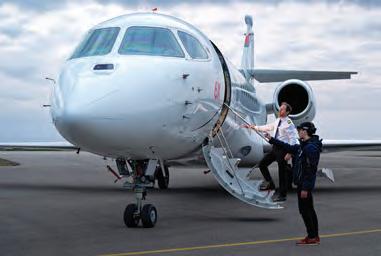
In the world of business jets, it’s all about passenger comfort.

22.
Helicopters are being integrated into the private jet experience.

Electric air taxi pioneers say they will compete with ground-based ride-hailing like Uber. Is that realistc?
27.
Tired of fying on unreliable and rigid airlines? Optons abound— but research is required.
Looking to land on your favorite back-country airstrip or lake? Or maybe just that short runway at your favorite resort? These single-engine turboprops may be just the tcket.
Survey results from one of our sister publicatons show which airport facilites ofer the best services and amenites.
Your latest ratngs of aircraf manufacturers and service providers, plus the jets, turboprops, and helicopters you’d like to own, and more.
Shopping for an airplane or helicopter? Start by reading some facts about the airframers whose products you’re considering.
56.
Key data about all popular models of jets, turboprops, and rotorcraf.



Scan the QR code to see the mission
Business Jet Traveler readers are nothing if not discerning, and our mission to maximize your investment in private jet travel has remained steadfast for more than two decades. Make sure you are subscribed to our free BJT Waypoints newsletter, which brings features such as aircraft reviews, updates on private lift providers and manufacturers, and interviews with notable business travelers straight to your inbox every week of the year. Thank you for your readership!
Jennifer English, Editorial Director


Editor-in-Chief Matt Thurber
Managing Editor Charles Alcock
Editorial Director, Head of People & Brand
Jennifer English
Production Manager Martha Jercinovich
Graphic Designer Grzegorz Rzekos
Contributors Chris Allsop, Curt Epstein, Mark Eveleigh, Narina Exelby, Margie Goldsmith, Mark Huber, Marilyn Jones, Debi Lander, James Wynbrandt
Director of Video Ian Whelan
Editorial contacts
214 Franklin Ave., Midland Park, NJ 07432 (201) 444-5075 • editor@bjtonline.com
Founder & Chair Emeritus Wilson S. Leach
Executive Chair Dave Leach
These are exciting times for business aviation, and BJT has been lucky enough to have a front row seat. I was there when Joby and Volocopter few their electric aircraft from the downtown Manhattan heliport to demonstrate the future of commuting. For more on this emerging technology, please see Charles Alcock’s feature “What Can You Expect From eVTOL Air Taxi Services?” (page 24) and Mark Huber’s “Good To The Last Mile” (page 22)
President Ruben Kempeneer
Director, Industry Affairs & Events Nancy O’Brien
ADVERTISING SALES
Michelle James–Midwestern U.S., Western U.S./Western Canada (520) 343-0236
Susan Joyce–Midwestern U.S.,Southeastern U.S./Caribbean/Brazil (303) 641-5505
Diana Scogna–Europe/Middle East (33) 6 62 52 25 47
Victoria Tod –Northeastern U.S./Eastern Canada/United Kingdom (203) 733-4184
Director Marketing & Client Services
Lisa Valladares
Audience Development Director Eileen Silberfeld
Marketing Specialist Alyssa Barry
Social Media Marketing Zach O’Brien
No BJT Buyers’ Guide is complete without a rundown of the latest and greatest in aircraft, and we have all the details you need here (pages 8-21), including turboprops (page 31)
Insider tip: Even if you can’t make it to Bombardier, Dassault, or Gulfstream in person, make sure to visit BJTonline.com to see our video walkthroughs of the latest ultra-longrange jets elevating technology and speed to new heights.


Sales Administrator Cindy Nesline
Manager of Finance & Human Resources
Tracy Britton
Accounts Payable Mary Avella
Accounts Receivable Bobbie Bing
Advertising Inquiries (201) 345-0085, adsales@bjtonline.com
Circulation/Subscription Inquiries (201) 345-0085, subscriptions@bjtonline.com

TO BUY OR SELL A BUSINESS JET?
At Duncan Aviation, we understand that buying or selling a jet is a profoundly personal journey. As your vital advisors, we ofer operational expertise and timely insights that go beyond the surface and support you throughout your ownership experiences. Our team’s dedication and vast network of industry connections ensure that every decision you make is thoroughly informed, aligning perfectly with your unique mission and aspirations.
www.DuncanAviation.aero/aircraftsales

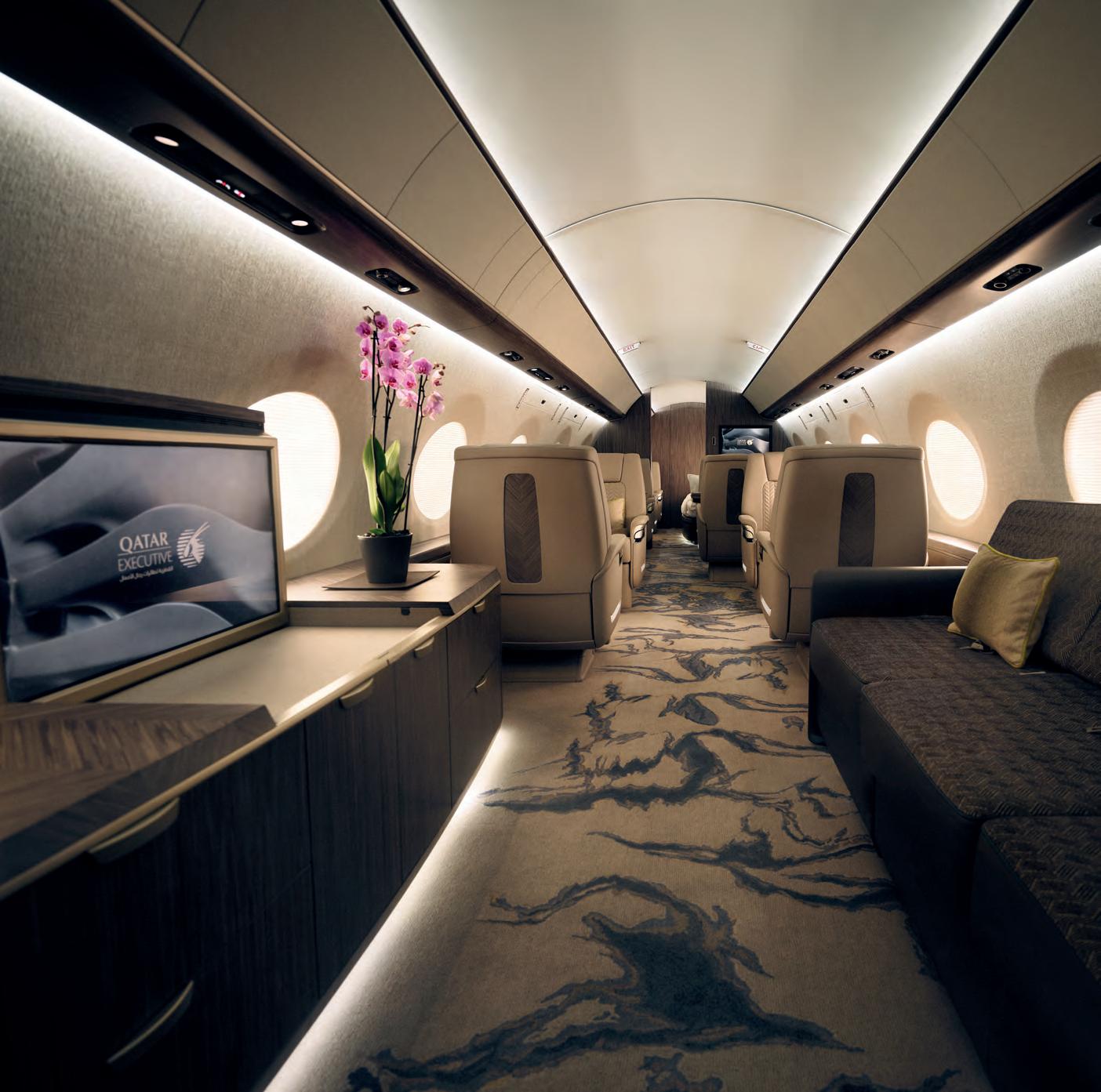

By James Wynbrandt
Anew generation of fagships—the G700 from Gulfstream Aerospace, Bombardier’s Global 8000, and the Dassault Falcon 6X—are taking command of the world’s ultra-long-range feets, vying for claim to the greatest range, tallest and widest cabin, maximum operating Mach number, lowest cabin altitude, and other superlatives.
With the three new bizjets coming to market within little more than a year (the Falcon 6X last November, the G700 this April, and the Global 8000 slated for the second half of 2025), bragging rights can be feeting.
Whatever the diferences at the corners of their envelopes, the three new ultra-long range jets—which by most defnitions include aircraft with a range of 5,000 or more nautical miles (nm)—feature proprietary cabin systems including circadianbased lighting to ease transitions between time zones; state-of the art air fltration and purifcation delivering fresh air devoid
of pathogens or other impurities; hi-def entertainment and secure high-speed Wi-Fi providing home/ofce connectivity in the sky; fy-by-wire digital fight controls; and noise-dampening technology that lowers ambient cabin sound levels to some 50 decibels, equivalent to a quiet ofce. The highest quality interior craftsmanship, styling, and customization options are a given.
One more common trait: For jets that place a premium on speed, the new fagships have been slow out of the gate, entering service two or more years behind schedule for reasons including Federal Aviation Administration (FAA) certifcation delays (the G700), project revamping (the Global 8000), and supply chain issues (the Falcon 6X).
The G700 from Gulfstream Aerospace combines “the very best elements from our most innovative products, and unites them with cutting-edge advances,” says company president Mark



















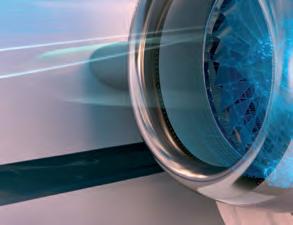






















Burns. Supplanting the G650, the new fagship takes honors for both longest range at 7,750 nm—50 nm farther than Bombardier’s current fagship, the Global 7500—and as the fastest business jet fying today, with a top speed of Mach 0.935, according to the Savannah, Georgia company. Outftted with purpose-developed high-thrust Rolls-Royce Pearl 700 engines and new winglets, the G700 has already established more than 50 city-pair speed records, while opening nonstop routes including New York to Hong Kong; London to Tokyo; and Los Angeles to Dubai.
Inside, the six-foot, three-inch-tall and eight-foot, twoinch-wide interior shares the same cross-section as the G650, but the stretched fuselage adds almost 10 feet to the now 57foot long main cabin, hosting up to fve living areas. An ultragalley, fexible six-place passenger lounge, and grand master suite with shower are among the layout options. At 41,000 feet, cabin altitude is 2,840 feet.
Price: $81 million (2024)
Bombardier aims to retake the longest-range title and add “the fastest business jet ever” to its portfolio with the Global 8000—“the absolute pinnacle of business aviation,” says president and CEO Éric Martel. The new Global’s projected 8,000 nm-plus range will link Houston and Dubai; Los Angeles and Singapore; and London and Perth, and its Mmo (maxi -
mum operating speed) limit of Mach 0.94 just outpaces the G700 (a fight test vehicle used for the Global 8000 program briefy went supersonic as part of certifcation). Moreover, the Global 8000 promises “the frst-ever transcontinental ultra-high-speed cruise of Mach 0.92,” the Montreal airframer says.
Sharing the same fuselage and cabin dimensions as the Global 7500 at six-foot, two-inches tall, eight feet wide, and 54 feet, fve inches long, the Global 8000 ofers a choice of three or four cabin zones with interior options including the category’s largest galley and the largest 4K TV on a business jet (55 inches). A three-zone “open ofce” executive cabin, designed for corporate collaboration, features Nuage zero-gravity seats. A four-zone cabin ofers a principal suite with full-size bed and stand-up shower. Cabin altitude is 2,900 feet at 41,000 feet.
The Global 8000 program launched in 2010 as a longerlegged but shorter cabin version of what became the Global 7500. Few buyers showed interest in trading interior space for range, and in 2022, fve years after the Global 8000’s initial 2017 service entry date, Bombardier announced the program’s reconfguration. The range improvement is mainly achieved by optimizing empty weight and creating more fuel storage capacity, while its next generation GE Passport engines each replace individual fan blades with a single titanium blisk, improving efciency and saving weight.
Price: $81 million (2024)


Though last among the three in range and airspeed, the Falcon 6X from Dassault Aviation achieves the largest advance in the category, signaling the French aerospace company’s intent to challenge the Bombardier-Gulfstream ultra-long-range duopoly. Branded as “the frst ultra-widebody” purpose-built business jet, the 6X features the tallest and widest cabin in business aviation, at six feet, six inches high, and eight feet, six inches wide.
“Times and trends change,” says Carlos Brana, executive vicepresident, civil aviation, of the break from the Falcon’s traditionally modest cabin cross sections. “Passengers want space and the comforts of home, especially on long fights.”
Range-wise, at 5,500 nm—though some 2,500 nm short of the G700 and Global 8000, and 1,000 nm less than Dassault’s own Falcon 8X—the 6X can link London and Hong Kong; Los Angeles and Geneva; and Beijing and San Francisco. The new Pratt & Whitney PurePower PW812D engines deliver an Mmo of Mach 0.90, along with double-digit improvements in fuel efficiency and emissions over currentgeneration turbofans.
The 40-foot, four-inch-long cabin is confgured in three zones, with options including a large entryway, a spacious rear lounge, and a crew rest area. Its industry-frst skylight over the galley area adds to the natural light, as do 30 windows, each
some 10 percent larger than in current-generation Falcons. Cabin altitude is 3,900 feet 41,000 feet.
The 6X also features faperons—a combination aileron and fap that optimize performance and handling—and the FalconScan diagnostics system, which monitors and reports on 100,000 6X maintenance parameters, both Falcon frsts.
Introduced in 2017, the 6X takes its fuselage cross-section from the canceled Falcon 5X program, shelved due to development snags with its intended Safran Silvercrest powerplant. Meanwhile, Dassault’s forthcoming Falcon 10X, scheduled for service entry in 2027, will ofer a projected 7,500-nm range and an even more expansive cabin at six feet, eight inches tall, nine feet, one inch wide, and 53 feet, 10 inches long, further escalating the aerial range wars.
Price: $54.9 million (2024)
In the interim, bragging rights remain in play. Gulfstream hopes to bring its G800 to market—an 8,000-nm range follow-on to the G700—before Bombardier’s Global 8000 enters service next year. A replacement for the G650/650ER, the G800 mates the G650ER fuselage with the G700’s wings. Precise range is undefned and Mmo is currently specifed at Mach 0.925, but don’t be surprised if Gulfstream tries to reclaim both the range and speed titles atop the leaderboard before the forthcoming jet’s ofcial performance numbers are announced. BJT

Experience comfort never before offered in this class of aircraft. Or the class above it.

In the world of business jets, it’s all about passenger comfort.
By Mark Huber
Bottom line for existing and potential private jet owners: If it’s in their beach house or Bentley, they want it in their airplane. If hot tubs were possible at 30,000 feet, they’d ask for those, too.
Every year, jet builders become incrementally better at meeting those rarefed expectations. Over the last decade alone, the market has seen demonstrable and dramatic improvements in passenger seat comfort and functionality, including better artifcial lighting, bigger cabin windows, and larger galleys and lavatories. Also: a collection of “whiz bang” technology—fast and seamless Wi-Fi and voice communication, larger TVs, onboard servers that can store whatever video or audio entertainment you like, and cabin management systems that allow you to control just about everything in the cabin from a touch panel at your seat or via your portable smart device. Commands include changing the cabin light color, ordering a drink, selecting a surround-sound movie, and adjusting the temperature.
Higher pounds-per-square-inch pressurization ratios mean lower cabin altitudes while cruising above the airliners— signifcantly reducing fatigue. In some aircraft this feature is combined with a cabin air humidifcation system to further enhance comfort.
These are the features necessary to compete in today’s business jet world. In the words of Leona Qi, president, U.S., at VistaJet, “We continue to challenge the boundaries of what is possible at 40,000 feet. This dedication is refected in initiatives like our Wellness program, exclusive to those fying onboard our Global 7500, which ofers ergonomic seating and jetlag-reducing technologies.”
Modern private jet cabins do almost everything except shine your shoes. It’s not just the functionality that’s improved, but rather the physical cabin itself—it’s bigger and more stylish. That’s across all categories, not just in the $81 million ultralong-range, large-cabin aircraft such as the Bombardier Global 7500, but even in $6 million light jets.






Blended Winglets are among the most desired business aircraft upgrades. The performance-boosting, fuel-saving, and range-extending mods catch the attention of jet buyers and reduce emissions. Increase future resale value for Dassault Falcon or Hawker business jets and enjoy the benefits now.




Trenched center aisles are increasingly giving way to uniformly fat foors and cleverly designed new cabin shells to increase head and shoulder room. Sidewall nooks hold additional personal efects. And there’s more room for luggage than ever before. Consider that a midsize Hawker 800 of the 1980s ofers 49 cubic feet of room for baggage, while today’s considerably smaller HondaJet provides 66, and the Cessna Citation CJ4, another light jet, ofers 77. After all, why have a private jet if you need to pack light?
Business Jet Traveler recently looked at how cabin features on various classes of business jet models have evolved.
Cirrus SF50 Vision Jet G2+
Ninety-six Vision Jets were delivered last year and it’s easy to see why. The latest version of this single-engine jet, the G2+, blends the best of minivan utility with luxury sports car styling to deliver an interior that is both highly useful and aestheti-
cally pleasing. The Vision Jet features modular seating for up to fve adults and two more optional jump seats suitable for small children.
The cabin is about fve feet wide, four feet high, and nearly 11 feet long. The interior ft and fnish quality is at a high level for an entry-level jet, with a cabin that includes luxurious automotive-style leather seats, high-end substrates, generous seat tracking, sidewall cut-outs for personal-item stowage, cup holders, armrests, USB power ports, airbag seatbelts (crew positions), and climate-controlled air-conditioning, with options for enhanced interior lighting, drop-down entertainment screens, Wi-Fi-ground link, and 110V AC power.
The centered aft engine positioning gives the airplane a more fexible center of gravity for loading, makes the engine easier to service and inspect before fights, and mitigates onboard noise and any damage to the cabin from an uncontained engine failure.
The G2+ adds improved cabin noise insulation and a higherpowered cabin pressurization system that allows the aircraft to maintain an 8,000-foot cabin at its new maximum operating


As an aircraft passenger, you rely on your pilots to handle technical and operational details of the flight. Go behind the scenes to learn how their training prepares them to safely get you to your destination.

For most people, weather is just a happy circumstance or a frustrating nuisance. For pilots, reading weather paterns is part of the job. They must decipher myriad sources of forecasted weather information during the flight planning process to determine routes, altitudes, fuel consumption, and time to destination.
When Mother Nature disrupts the flight plan, a highly skilled pilot will make adjustments to determine the best course of action. Training providers like FlightSafety International (FSI) ensure pilots understand how to weigh factors like time, distance, fuel, passenger convenience, and safety to create the right plan for any weather condition.
Density altitude can effectively shorten runways—but pilots can train to accommodate this factor. Essentially, density altitude indicates the altitude that the aircraft “thinks” it’s flying at based on atmospheric conditions. As an aircraft
climbs into higher, less dense air, its performance generally decreases due to many factors. At high-density altitudes, aircraft need more runway to take off, cannot climb as quickly or as steeply, and need a longer landing roll.
The three factors that affect density altitude are the elevation of the airport, outside air temperature, and humidity, with humidity having the smallest effect on aircraft performance. A high-elevation airport such as Aspen (7,820 feet) on an 82˚F summer afternoon may have a density altitude of more than 10,500 feet, even with a relatively low 17% humidity. This means an aircraft taking off or landing at this airport would perform as if it’s at more than 10,000 feet—and operations can become more challenging when the temperature rises.
“During simulator training, the pilots perform density altitude calculations for operations in these [high and hot] conditions and then we have them actually fly these scenarios,” said Richard Meikle, Executive Vice President Safety, Courseware, and Compliance at FSI. “If
you’re used to fairly rapid climb-outs away from airports, and then the instructor positions the simulator to a high-density altitude airport, the performance is noticeably degraded. The instructors can adjust the simulated weight of the aircraft and the temperature to allow clients to experience and understand the different performance levels.”
While density altitude affects all aircraft to some degree, it affects pistonpowered aircraft more than turboprops or jets simply because of the later’s higher thrust-to-weight ratio.
“Not all airplanes are created equal,” said Meikle. “Sometimes it’s very difficult for an owner or passenger to see some aircraft departing from an airport and hear from your pilot that your aircraft can’t depart because it doesn’t meet the performance requirements.”
In the opposite extreme, cold weather can also affect an aircraft’s performance. Frost on the wings can alter the airfoil
shape and disrupt airflow enough to considerably hinder the generation of lift. This is why it’s important to hangar your aircraft and/or ensure it is completely de-iced prior to takeoff in frostforming conditions. Anti-icing systems also draw power from the engine’s bleed air system, reducing engine performance. This can especially be a factor at high-elevation airports.
In addition, wet or icy runways can decrease airport capacity or even prevent specific aircraft from landing at all. During preflight planning, pilots note the length and condition of the runway(s) at the destination airport to ensure that the aircraft they are flying can stop in the given distance. They will take many factors into consideration: whether the runway is grooved (providing additional traction and water runoff capability) or ungrooved, wind direction, airport altitude, density altitude, and the required length of runway for the given conditions.
However, even with this information, runway excursions account for more than a third of all aviation accidents each year.
“Landing on a runway that has now become wet when the airplane performance doesn’t support it is extremely dangerous,” said Mark Kleinhans,
director of safety for FSI. “The two best ways to handle this are to either divert to an airport that has a longer runway or wait for the weather to pass and the runway to dry. Either option may inconvenience the passengers but is beter than a damaged aircraft or worse.”
Since airflow over the wings (or rotor blades in the case of helicopters) generates the lift that enables the aircraft to fly, wind is an important element during takeoff and landing. A headwind straight down the runway is preferable as it assists in the generation of lift on takeoff and helps slow the aircraft on landing. A tailwind down the runway is undesirable since it negates lift on takeoff and pushes the aircraft on landing (causing a longer, more squirrelly landing roll). In addition, crosswinds can push the aircraft off the runway if they are strong enough.
“High, gusty winds low to the ground can cause turbulence and wind shear, which make it very difficult for pilots to keep a smooth, stabilized approach to landing,” said Meikle. “If an airplane is drifting, floating, too fast or too slow, too high or too low on final, the pilots often elect to go around and set up for another

approach. Pilots are trained to execute go-arounds, which are much safer than trying to force an aircraft down in an unstable condition.”
Sometimes the impetus of a go-around starts well before the final approach. Air traffic control demands that seem benign 100 miles out can result in an unstabilized approach. For example, if air traffic control (ATC) keeps your aircraft at a higher altitude than planned to allow another aircraft to pass under you, by the time they let your aircraft descend, your approach is steeper and faster than planned. With some high-performance aircraft, that speed is difficult to bleed off in time to make a good approach.
Meikle says that pilots are missionoriented, and they want to complete the planned flight as much as the passengers want to be on the ground. “It’s important that pilots are recognized for making the good decision when they go around, regardless of the cause,” Meikle said. “If they’re in a position where they feel like the go-around was the best option, they should be thanked for making the right decision.”
Even when the weather is perfect in the area you’re leaving, you may be hit with

delays due to weather in other parts of the country.
“Storm fronts can extend hundreds of miles across from multiple states and affect an entire region of the country,” said Meikle. “The most extreme thunderstorms can tower more than 55,000 feet, which is higher than the service ceiling of any passenger or business jet.”
Since these thunderstorms (technically called cumulonimbus clouds) generate updrafts and downdrafts of tremendous force, and hail that can cause significant damage to an aircraft, ATC often route traffic—both commercial and private—hundreds of miles out of the way when a storm front of sufficient height and ferocity cuts across a planned flight path. The rerouting can affect hundreds of flights, creating pinch points at the areas north and south of a storm front, which typically travels from the west to the east in North America (hurricanes and other localized wind patterns can disrupt this usual flow). The rerouting increases ATC’s workload as it provides multiple course and altitude changes to hundreds of aircraft to work them safely through the pinch points.
Weather directly affecting major airports also plays a role in the national airspace system. As the weather deteriorates and visibility decreases, the number of aircraft that a particular airport can handle also decreases. For example, at Chicago’s O’Hare International Airport—one of the busiest in the world—an aircraft typically lands about every 30 seconds for a visual capacity of about 119 arrivals per hour. But when visibility is less than 3 statute miles, the airport capacity can drop to as low as 94 arrivals per hour. This means that upon arrival at the airport, some aircraft must circle and wait for their turn to land.
“In this situation, instead of stacking aircraft in long orbits at different
altitudes near the airport, ATC may hold aircraft that haven’t departed yet on the ground,” said Meikle. “They can either call a ground stop—which prevents any aircraft on a flight plan to land at specific airports from departing anywhere in the U.S.—or hold all aircraft in a specific region.”
While ground holds may be frustrating to passengers, they are safer than in-air orbits and may ultimately help the passengers reach their destination. Consider an airport like Teterboro, NJ, a popular destination for business aircraft. In very close proximity, there are three major airports with high volumes of airline traffic. When weather approaches the area, the normal departure and arrival paths may be cut off and limited routing options exist for safe operations. This is when ATC will implement a ground delay and hold programs to ensure there is sufficient space for aircraft to safely navigate through the gaps in the weather.
“Aircraft on ground holds use litle to no fuel, depending on how long the hold is and when the pilots are notified,” said Meikle. “Whereas aircraft can be in holding paterns for so long that they reach a critical fuel level and must divert to a different airport to land safely.”

Passengers can check the status of the national airspace system and delays at specific airports at https://nasstatus. faa.gov/.
One way to reduce anxiety caused by weather delays is to build a buffer in your schedule. Just as pilots plan their flights with at least 45-minute fuel reserves, schedule your flight with a comfortable “time reserve” to account for any unexpected delay. You can also discuss weather and diversion options with your pilot before takeoff. Diversion decisions often need to be made well in advance of landing to arrange for ground transportation, since you’re not landing at the designated airport.
“It’s much easier to have a discussion with your pilot on the ground if there’s any possibility that the flight may have to divert, especially if your destination is in a mountainous area,” said Meikle. “A more suitable airport 10 miles away in a straight line may look great to your pilot, but may add more than an hour of drive time for you if you’re driving on mountain roads, and you might have a beter alternative that works for both of you.”
RICHARD MEIKLE
FlightSafety Executive Vice President Safety, Courseware, and Compliance
“ “
If an airplane is drifting, floating, too fast or too slow, too high or too low on final, the pilots often elect to go around and set up for another approach. Pilots are trained to execute go-arounds, which are much safer than trying to force an aircraft down in an unstable condition.

“Thank you for saving my life and the lives of my passengers.”
There’s nothing quite as gratifying as saving the life of another human being. For the team at FlightSafety International, receiving a call, leter, or email from a customer expressing heartfelt gratitude for providing training that literally has saved one or more lives makes the job more than worthwhile.
“In 2020, we implemented an inadvertent flight into IMC [instrument meteorological conditions] module in all of our helicopter courses, and all helicopter pilots take it whether they are instrument rated or not,” said Richard Meikle, EVP Safety, Courseware and Compliance, noting that it was the pilots’ spacial disorientation in IMC that killed basketball star Kobe Bryant, family, and friends in January 2020. “Since then, we’ve had at least four emails from pilots saying that training literally saved their life. None of those pilots were required by regulation to get this IMC training because they were flying under visual flight rules
(VFR), but by providing training beyond the regulations, we made them safer pilots who made it home.”
The ultimate goal of training is to enhance pilot safety, but as long as humans are piloting the ship, they will still have human traits, tendencies, and foibles. Meikle says there are three key traits that define a safe pilot: knowing and operating within one’s limitations, applying discipline to one’s thoughts and actions, and assessing the situation before acting.
“Impulsive action in an aircraft can have bad consequences,” said Meikle. “There are, of course, times where you have to act very promptly and that assessment phase may be quite short—such as an engine failure on takeoff—but those events are relatively rare. Generally, you have enough time to assess the situation and make an informed decision before you take action.”
Disciplined thought includes the methodical use of checklists and following standard operating procedures (SOPs)
for every flight. Sometimes familiarity with an aircraft or beautiful flying conditions can lull pilots into shortcuting procedures or skipping the checklist. But well-trained, disciplined pilots recognize that daily habits become ingrained and good habits can be more quickly recalled when something goes awry; a pilot used to using checklists won’t need to fumble for them in an emergency situation.
Pilots who know and operate within their limitations tend to be safer pilots because they don’t often create emergency situations: the VFR pilot who lands in deteriorating weather short of their destination, the charter pilot who declines a severely overloaded trip, or the bizjet pilot who diverts to a dry runway when an unexpected rain shower makes a short field too tight to land safely.
According to Meikle, “Limitations include those of the aircraft they are flying, airspace and operational limitations, and the pilot’s own personal limitations in terms of competency, experience, and training with regard to the upcoming flight.”
Training is one way that pilots learn the extent of these limitations and can, in certain circumstances, expand them. A pilot who knows the aircraft systems and operational performance of their aircraft is less limited than an unfamiliar pilot who isn’t sure.
“From a safety point of view, we train pilots all the way the aircraft limits, but we encourage them to maintain a set of more conservative personal limits based on their experience in total, and in the aircraft for the conditions” said Mark Kleinhans, FSI’s director of safety. “Their skillset exceeds the requirements of each flight. We have to ensure there are no gaps in knowledge or skills.”
One way pilots can address their personal limitations is through FlightSafety’s Master Aviator program. Launched in 2015 for fixed-wing pilots and in 2016 for helicopter pilots, the Master Aviator program awards pilots
for completing a set of core and elective courses beyond the typical initial or recurrent training events.
“The Master Aviator program is a terrific indicator to pilots of the commitment of their flight department and the individuals within to enhance their skills beyond the core,” said Meikle. “It takes most pilots a couple of years to complete all of the requirements for a particular aircraft, and pilots can earn Master Aviator in multiple aircraft to really hone their skills on each.”
Advanced simulator courses in rejected takeoffs, helicopter approach and landing accident reduction, crew resource management, energy management, using night vision goggles, upset prevention and recovery training, and international procedures strengthen pilots’ abilities to handle these situations. Elective online courses include topics such as fatigue management, warm/cold weather operations, corporate aviation security, safety management systems, and weather radar.

“Any pilot who completes one of our core courses is a safe, competent pilot, but the Master Aviator program takes them to the next level,” said Kleinhans. “Think of it like this: most everyone who drives a car knows how to drive defensively and how to avoid accidents, but none of us are qualified to be a security detail for the president of the United States. The president’s limo driver is trained to a higher level. And that’s what the Master Aviator is designed to do.”
When pilots complete initial or recurrent training at FlightSafety, they get much more than practice simply flying the aircraft. FlightSafety curriculum is continuously updated to incorporate various human factors topics such as communication, leadership and teamwork, workload management, problem-solving and decision-making, and situational awareness. In addition, FlightSafety keeps its finger on the pulse of the industry to address key concerns like runway incursions/excursions, unstable approaches, and the reluctance to go around in its course materials.
“We try to bring awareness of what’s happening in the industry to the classroom so pilots gain an appreciation for what’s going on outside of their own operations,” said Meikle. “If you understand what’s going on in the industry, there may be a nugget or two that you can bring back to your own operation to make it even safer than it is now.”
FlightSafety’s partnerships with GE Aerospace and the Presage Group have fostered innovation in teaching and reinforcing core pilot competencies based on actual industry and pilot data. Through GE Aerospace’s flight data analytics program, FlightSafety can access aggregated flight data from thousands of aircraft and analyze trends that affect
how pilots fly specific aircraft types in various situations. The insights provided are then worked into the curriculum. For example, when the data showed a link between unstable approaches and runway excursions, the FSI team created a “spotlight” to focus on runway excursion prevention in every fixed-wing initial or recurrent course.
Executing a “go-around” during an unstable approach is often the best way to prevent a runway excursion. Yet the data indicated that only about 3% of unstable approaches resulted in go-arounds; during the rest, the pilots wrestled the aircraft to the ground, usually with a favorable outcome albeit with reduced safety margins and in some cases, narrowly avoiding a serious event. FlightSafety worked with the Presage Group to study the psychology of the go-around using simulators to fly various approaches and interviewing the pilots afterward about their decision to go or not go around. Presage and FSI then jointly developed course content and scenarios for use in training.

MARK KLEINHANS FlightSafety’s Director of Safety
When we hire a new instructor, we go beyond checking the boxes to make them legal to be an instructor.
“

FlightSafety’s investment in its curriculum isn’t always externally driven; in fact, its initial and continual investment in instructors and classroom technology has kept it ahead of its competitors for decades.
“When we hire a new instructor, we go beyond checking the boxes to make them legal to be an instructor,” said Kleinhans. “It’s a long process to become a FlightSafety instructor, including learning how to train clients that have deficiencies or need additional practice, and how to challenge those who have clear mastery of the aircraft. We invest a lot in how our instructors actually deliver the training because our philosophy is to train not just what’s required but what will actually keep people safe.”
Recognizing that the learning styles of students have changed over the years, FlightSafety also strives to provide the best learning aids for each client.
“Pilots in my generation are used to receiving a book, a booklet to take notes in, and a highlighter,” said Meikle. “If you did that to many of the clients walking
in today, they would not be impressed because they expect the content to be digital. But on the other hand, if you gave me an iPad with the course loaded on it and told me to take my notes on the iPad, it would be quite frustrating. So technology cannot be a one-size-fits-all solution.”
Meikle noted that for technology to work in the classroom, it must be intuitive. Students shouldn’t need to spend too much time learning how to use the technology before they get to the content. This is one reason that FlightSafety has limited its use of technologies such as virtual reality and eye tracking to specific applications like hands-on maintenance training and instrument training in helicopters.
“Technology is great, but it can’t be added simply for the wow factor,” said Kleinhans. “In some ways, it may feel like we move more slowly than the marketplace allows, but we are being intentional with the integration of technology in our classrooms. We’re trying to make sure that any technology we deploy improves the training environment [and does] not detract from it.”

altitude of 31,000 feet. The aircraft can be equipped with the Gogo Avance L3 air-to-ground connectivity solution, a comparatively economical way to access the web, email, moving maps, and fight information.
Although it fts into the light jet category, the Phenom 100EX shares many features of its larger siblings, such as upper tech panels, wider seats with a two-inch backrest gain and extra knee support, increased use of more sustainable materials, and fush-to-the-wall tables. The EX version also has the previously optional side-facing ffth seat and belted lavatory as standard features.
Customers can choose from four interior color schemes— navy blue, gray, tan, and black—and three new seat styles. The interior also makes more use of leather and eco-friendly Ultra Leather and fewer veneers to maximize durability and maintainability.
The 100EX’s cockpit was also enhanced by adding more pilot legroom and an open-concept cockpit for easier communication within the cabin. In addition, the 100EX is the frst light jet equipped with a runway overrun awareness and alerting system, which enhances safety during critical takeof and landing operations.
These three models—the M2 Gen2, Citation CJ3 Gen2, and CJ4 Gen2—comprise Cessna’s current light jet oferings.
A descendant of the CJ1+, the M2 Gen2 began deliveries in 2022. Improvements include three more inches of cockpit legroom and a cabin with more durable materials, new sidewall ledges, a choice of wood or carpet fooring materials, accent lighting, illuminated cupholders, and wireless and USB charging ports at each passenger seat.
Deliveries of the newest iteration of the CJ3, the CJ3 Gen2, are scheduled to begin in 2025. Improvements include reworked entry steps with grab handles, more cockpit legroom, and a fold-down, side-facing single seat opposite the entry door. Between-seat slimline tables have been added along with USB-C charging ports at every seat and wireless charging.
The CJ4 Gen2’s cabin is 21 inches longer than the CJ3’s. Added features include new folding airstairs, ambient lighting, and a galley with improved storage. The infight entertainment system was enhanced with a wireless cabin management system that comes with a media server that can stream preloaded audio and video fles, access SiriusXM satellite radio, and display moving maps.

On the larger end of the light jet spectrum, both Embraer’s Phenom 300E and the Pilatus PC-24 remain strong sellers and both aircraft have recently undergone signifcant cabin modernizations.
The 300E features the Lufthansa Technik Nice-HD cabin management system, a quieter cabin, and the available Bossa Nova interior that includes revised seat stitching, carbon-fber accents, piano-black veneer, accent leather, and gold plating. Embraer was the frst business jet manufacturer to certify a runway overrun awareness and alerting system, in the Phenom 300E, which also ofers autothrottle, coupled go-around, and emergency descent mode.
The PC-24 adds a new, 6-foot, 6-inch long three-place, side-facing divan that converts into a bed, new cabin management and audio systems, and a payload increase of 600 pounds. As a result, the PC-24’s range grew to 2,040 nautical miles.
Other improvements include reduced ambient noise through improvements to passenger service unit ducting and tuned engine accessory air intake ducts, and the addition of noiseabsorbing panels. An integrated Lufthansa Technik cabin management system features a 10-inch touchscreen controller with a 3D moving map, four high-fdelity speakers with a sub-woofer option, mood lighting, USB ports, and a media storage server .
Embraer delivered 41 Praetors in 2023. The aircraft are improved midsize and super-midsize jets derived from the Legacy 450 and 500 models and ofer redesigned cabins, tweaked engines, new winglets, more fuel capacity, and upgraded avionics. Both are two-pilot aircraft. The 500 features seating for seven to nine passengers and has a maximum range of 3,340 nautical miles, while the 600 has room for eight to 12 passengers and a maximum range of 4,018 nautical miles. Baggage capacity is very generous for aircraft in these classes: 150 cubic feet in the 500 and 155 in the 600.
These aircraft compete directly with the midsize Citation Latitude and super-midsize Citation Longitude, both from Textron Aviation’s Cessna division. The Praetor 600 actually bests the Longitude in terms of range and cabin width, and unlike the Longitude, it ofers full fy-by-wire fight controls.
Improvements over the Legacy models are particularly noticeable in the cabin. The stylish Bossa Nova interiors are heavy on carbon fber, piano-black accents, and elegant stitch patterns. The cabin altitude is just 5,800 feet while the aircraft is at 45,000 feet. Passengers can enjoy optional high-speed Viasat Ka-band connectivity for streaming even large fles.
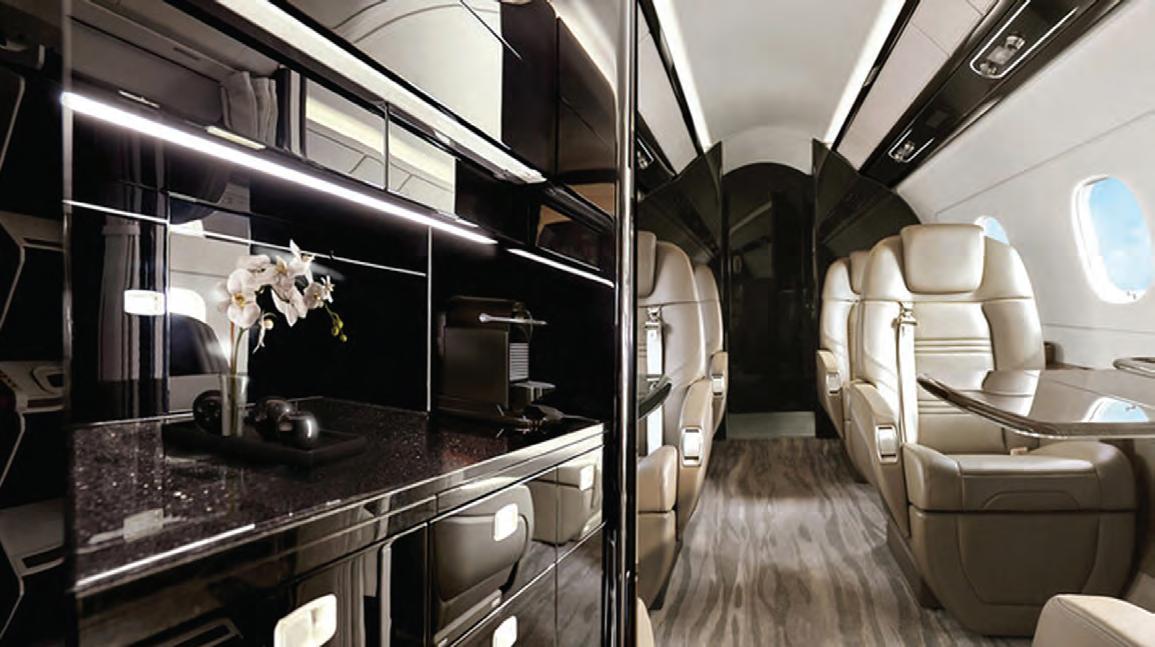

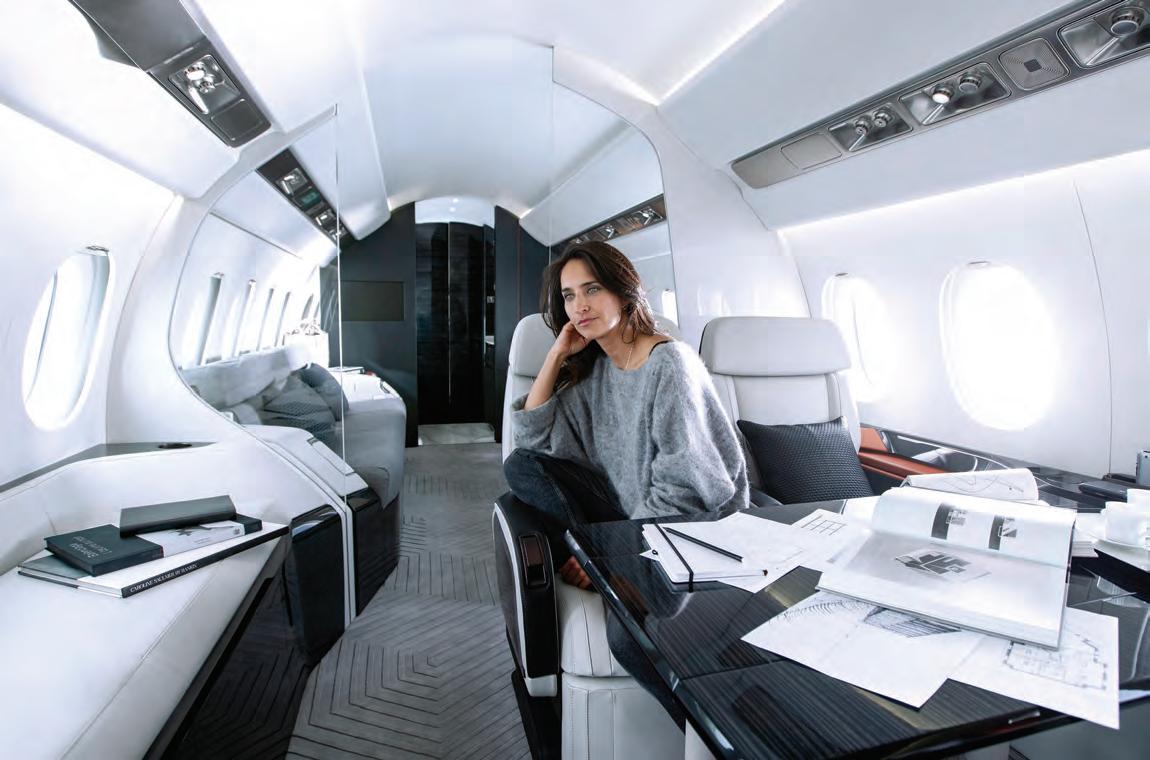
Gogo Avance L5 air-to-ground high-speed connectivity covering the U.S. and parts of Canada is also optional.
An “upper tech panel” displays fight information and cabin management controls that appear when needed, then vanish, leaving a clean, smooth look. A new, three-place divan (on the 600) is more orthopedically friendly, with a 105-degree seating angle. In 2020, Embraer enhanced the air quality in the interior with the addition of COVID-era HEPA flters and a one-touch electric lavatory door.
Last year, fractional provider NetJets announced an order for up to 250 Praetor 500s with deliveries beginning in 2025.
The Cessna Citation Latitude (midsize) and Longitude, Bombardier Challenger 3500, and Gulfstream G280 (all super-midsize) are popular choices in these categories. The Latitude and Longitude share the same fat foor cabin cross-section (72 inches tall, 77 inches wide), but the Latitude’s cabin is 3 feet, 5 inches shorter. Both feature a new seating design. NetJets

placed substantial new orders and options for both models as part of a 1,500 aircraft deal worth an estimated $30 billion.
The Challenger 3500 is the latest version of the Challenger 300 series that began deliveries in 2004. The 3500 incorporates many of the advanced cabin features, including the redesigned, zero-gravity Nuage seating architecture of Bombardier’s current fagship, the Global 7500. While Gulfstream reportedly is working on a successor aircraft to the G280, it continues to refne the existing product and last year began ofering it with a lower cabin altitude (reduced to 4,800 at 41,000 feet) and a plasma ionization clean air system.
Dassault Falcon 6X
Deliveries of the 6X began earlier this year. The 12- to 14-passenger aircraft has the largest cross-section of any inproduction, purpose-designed business jet: eight and a half feet wide, six and a half feet high, and just over 40 feet long yielding 1,843 cubic feet of volume. A skylight illuminates the
entryway, and 30 windows food the space with natural light. All that room allows for a good deal of fexibility, including the ability to have conference-table seating for six and a comfortable aft stateroom. The wider cabin also makes it possible for the 6X to ofer a bigger galley. The 155-cubic-foot baggage compartment is accessible in fight, plus there are another 76 cubic feet of unpressurized baggage space.
The environmental system delivers a cabin altitude of 3,900 feet while the aircraft is at 41,000 feet. The air-fltration system both circulates and refreshes air every two to three minutes, and the cabin is extremely quiet. High-speed satellite connectivity via FalconConnect will be on par with what the most sophisticated home or ofce equipment delivers. The system provides simplifed cabin management and entertainment control wirelessly through personal devices while providing seamless, global communications.
The 7500 features a four-zone, 2,637-cubic-foot passenger cabin with the Lufthansa Nice Touch cabin management system, Nuage zero-gravity single executive seats, and Soleil cabin lighting designed with circadian rhythm-based technology to combat jet lag; a large galley; and a dedicated crew suite. The galley is 20 percent larger than that on the Global 6000, with

double convection/microwave/steam oven capabilities. Range is 7,700 nautical miles.
Other cabin features include a center lounge/media room with 42- to 50-inch fat-screen monitors; adjustable color LEDs in the ceiling; a conference/dining table that seats six; a private stateroom; an optional stand-up steam shower; a more robust environmental-control system; and a capacious 195-cubic-foot baggage hold. An integrated cabin-management and in-fightentertainment system allows passengers to control LED lighting and window shades as well as having communication, entertainment, and information access and streaming via personal smart devices using new high-speed, Ka-band satellite technology.
What makes the G700 a true luxury long-hauler is the available Grand Suite in the aft fuselage. It can be equipped with a curved-edge, queen-size bed opposite a full-size dresser. The adjacent aft lav features two windows, a stand-up closet, a large vanity, and an optional stand-up shower. The lav also provides in-fight access to the pressurized, 195-cubic-foot baggage hold.
The G700’s range is 7,750 nautical miles at Mach 0.85 and 6,650 nautical miles at Mach 0.90. Top speed is Mach 0.935. The cabin altitude is just 2,840 feet at 41,000 feet, meaning passengers should experience less fatigue on fights. BJT
For more on ultra-long range jets, see page 8.
By Mark Huber
Sometimes the worst part of the private jet experience is the commute to the airport. With that in mind, in 2022 fractional operator Flexjet formed its own vertical lift division after acquiring helicopter service providers AAG in the U.S. and Halo Aviation in the UK in 2021. Customers can now apply their fxed-wing fractional hours to helicopter service on an interchange basis. For a nominal extra charge, Flexjet will even arrange ground transportation to make the journey truly seamless.
Flexjet Vertical Lift provides the service with 21 helicopters in three main areas: New York City/Northeast, South Florida/ Bahamas, and London. New York and London have long been popular helicopter passenger markets, but the popularity of the service in South Florida surprised Eli Flint, president of Flexjet Vertical Lift. “It’s demand we weren’t quite anticipating,” he said. “I was blown away.”
The service there covers an area with borders roughly between Palm Beach to Naples, to Key West, and over to the Bahamas from a base at Miami-Opa locka Executive Airport (KOPF). Flexjet initially moved two of its Sikorsky S-76 twin-engine helicopters from New York to cover the market. The service
uses landing facilities in areas designed to maximize customer convenience, such as the helipad atop the headquarters building of the Warren Henry Automotive Group in North Miami or North County Airport (F45) in West Palm Beach.
For the London helicopter market, Flexjet operates a feet of 10 six- and eight-seat Leonardo AW109 and AW169 models. Flint pointed out that the British have long appreciated the utility of executive helicopters.
Accessing helicopter service is relatively simple, Flint said. “When a fxed-wing owner wants to use helicopters, we have a dedicated person on the owner services team in Cleveland. All he does is facilitate communication between the fxed-wing team and the helicopter team.”
While the UK-based AW109s are somewhat smaller than the S-76s and AW169s, all of Flexjet’s helicopters are twin-engine and fown with two pilots. “The AW109s are really popular in the UK. The British love them and they are used to them, but we fy them multi-crew even though a lot of European operators fy them single-pilot. We don’t do that even if it means giving up the ability to carry another passenger in the back,” Flint said. “All of the safety standards, operating procedures, and resources



that we have in jets we’ve extended to helicopters. That includes the level of pilots we hire and maintain, the level of safety oversight, and the program credentials.”
Flexjet also is planning on adding electric vertical takeof and landing (eVTOL) aircraft to its helicopter service once those aircraft become available. “We want to make sure we are at the forefront of it. We’re looking at everything and have visited all the production facilities,” Flint said. “I think it is going to happen.”
In 2021, Flexjet sister company OneSky Flight ordered 200 eVTOLs from Embraer-funded Eve Air Mobility. It plans to deploy 100 in the U.S. and 100 in the UK. Fractional competitor NetJets also has placed a substantial eVTOL order from Lilium. Flexjet’s eVTOL service could begin as early as 2026. Adding eVTOLs to the mix promises to exponentially expand vertical fight passenger service from far more locations, according to Rob Wiesenthal, CEO of Blade Urban Air Mobility. Blade brokers integrated helicopter and jet trips with its BladeOne seasonal service between New York’s Westchester County Airport (KHPN) and Miami and Palm Beach, Florida. Jets at Westchester are linked via helicopter service from the West Side of Manhattan. Blade also collaborates with private jet service providers to deliver seamless service to special events and seasonal attractions such as the Monaco Yacht Show, where a one-hour drive becomes a seven-minute helicopter fight.
Last year Blade and Beta Technologies collaborated to perform the frst test of a piloted eVTOL in the greater New York City area. In April 2021, Blade agreed to facilitate the purchase of up to 20 Beta Alia 250 aircraft by its network of operators. Blade intends for these aircraft to be deployed on routes between its network of dedicated terminals in the U.S.
“The most important urban air mobility service in the world is our New York to JFK/ New York to Newark Airport product,”
Wiesenthal noted. Blade ofers an annual airport pass for the by-the-seat service for $735. After that customers can fy as much as they want on the routes for as little as $95 each way.
Infrastructure is the key to growing the eVTOL market, he said, both in terms of terminal infrastructure and existing customers and routes. Wiesenthal believes eVTOLs and helicopters will go through a “cohabitation phase” because “not every platform is right for the mission” and the market will require “diferent use cases” depending on the mission. But he thinks that predictions that eVTOLs will become so pervasive as to darken the skies and become fxtures on every rooftop are wildly exaggerated. “That’s just not the near-term or even mid-term reality. These are going to be shared operations where you’re on a schedule or operating continuously. You’re not going to be able to go on an app and all of a sudden have an aircraft land on your building and for forty bucks go wherever you want.”
Government has, and will continue to play a large role, mainly via the provision of incentives to encourage eVTOL use, Wiesenthal believes. He said this could take the form of allowing “longer operating hours, not having [noise] curfews, [charging] lower landing fees,” and facilitating the installation of electric charging stations. However, Wiesenthal and some others think that the widespread use of eVTOLs will frst emerge outside the U.S., most likely in the Middle East.
“The governments throughout the Middle East have been very proactive in trying to prove their technological prowess. They’re interested in becoming City 2.0 and you will likely see certifcation there frst. That’s important to these manufacturers and I think it’s a great proving ground for them. We’re excited about it, and then you’re going to see it come back to the United States,” he said.
But no matter how or where the eVTOL market evolves, it promises to enhance last-mile service, making the trip to the airport that much more convenient. BJT

Electric air taxi pioneers say they will compete with ground-based ride-hailing like Uber, but is that realistc?
By Charles Alcock
You’ve paid a small fortune to be in the back of that stretch limo. The water you’ve been ofered comes from an artisanal spring in France’s Auvergne region and is bottled by monks chanting in Latin. But you’re still the trafc-gridlocked chump watching a 1992 Ford Taurus edge ahead of you in the crawl to the airport. You’re going to want those monks praying that you don’t miss your fight.
That isn’t text from marketing materials produced by one of the start-ups preparing to launch air taxi services using new eVTOL aircraft, but it very well could be. Electric vertical takeof and landing vehicles have been conceived as congestionbusters, promising a guilt-free way to fy short distances without spewing excess carbon dioxide into the atmosphere or alienating the masses with noise from your helicopter.
Frontrunners like Joby and Archer in the U.S. say they will have their four-seat aircraft certifed by the FAA around the end of 2024, with deliveries to operators and the launch of taxi fights in select locations from 2025. At least, that’s what they are telling their investors. Many industry observers ques-
tion whether the regulators will move that fast. Nonetheless, eVTOLs are coming, and here’s what you can expect from companies including Supernal, Lilium, Volocopter, Eve Air Mobility, and Vertical Aerospace.
In the on-demand business model, passengers will book seats on phone apps for aircraft departing from whichever of

the new vertiports is closest to their current location. This may well require a connecting car journey with a ridehailing provider like Uber or Lyft— that in theory could be arranged via the same app.
In the early days of eVTOLs, Archer estimates that prices will be close to that of Uber Black or Premium rides at maybe $6 per passenger per mile. It says this compares with around $11 in a chartered helicopter, but this is based on the assumption that all seats will be flled.
Joby is also targeting pricing comparable to Uber Black and said it is simulating pricing mechanisms to manage supply and demand. The on-demand model hinges on per-seat pricing, meaning that passengers will share the ride with strangers, although Joby said that customers could book multiple seats for small group trips.
As aircraft numbers increase along with competition between service providers, prices could edge closer to Uber X rates at between $2 and $3 per passenger per mile. Archer claims that beyond 2030, prices could fall even further.
Initially, the vertiports may just be repurposed existing heliports already in use by old-school rotorcraft. Ground infrastructure companies such as Skyports and Ferrovial are investing in plans to develop networks of vertiports in new locations that could include top foors of parking lots or next to major train stations to provide easier connections between modes of transportation. To be clear, these eVTOLs are not (yet) going to be able to drop you on your front lawn after a night sipping cocktails downtown.
The vertiports will be ftted with equipment to recharge the batteries of the eVTOL aircraft. Most of the new













































vehicles are expected to be able to fy several short hops before having to be recharged. Full recharging of battery packs could take around 45 minutes, so the air taxi services will need to manage aircraft availability carefully.
Battery capacity is the main limitation on how far eVTOL aircraft can fy. Generally speaking, the maximum range is capped at around 100 miles, but many of the early air taxi services will be far shorter at 30 or 40 miles tops.
Some of the earliest services are likely to be airport transfers to and from city centers. Archer has a partnership with United Airlines to ofer fights from Manhattan to Newark Liberty International Airport in New Jersey, and also from downtown Chicago to O’Hare International Airport. Its rival Joby has a similar alliance in the works with Delta Air Lines, promising seven-minute rides to JFK International Airport.
“We are working with Delta to ofer the opportunity for their customers to reserve a seat for seamless short-range journeys to and from city airports when booking Delta travel,” a Joby spokeswoman explained to BJT. “Booking will also be available directly through Joby’s mobile-frst app, as well as with other partners such as Uber.”
At least for now, eVTOL connections to airports will have to drop of passengers groundside, meaning they will still have to endure security screening one way or another. However, eVTOL manufacturers and operators have been striking agreements with FBO groups including Atlantic Aviation, Signature Aviation, and Clay Lacy Aviation. This raises the prospect of business jet passengers being permitted seamless boarding if the TSA permits this approach.
In early August, Archer, whose aircraft is called Midnight, revealed a list of planned vertiport locations across the Greater Los Angeles area, confrming ambitions to launch services there in 2026. The sites include Los Angeles International, Orange


County, Santa Monica, Hollywood Burbank, Long Beach, and Van Nuys airports.
The University of California is looking at putting vertiports at existing helipads on its campuses. The Los Angeles Rams NFL team wants to have eVTOL connections between the SoFi stadium and Woodland Hills, where it has its practice facility.
Exactly how many linebackers will ft in these compact aircraft remains to be seen. The anticipated maximum payload is expected to be around 1,000 pounds, so after accounting for a pilot and four passengers, there won’t be much space to spare for baggage. Both Joby and Eve Air Mobility, an ofshoot of business jet manufacturer Embraer, have said that each eVTOL passenger will be able to take a standard airline carry-on bag and one personal item onboard.
If you’re reading this from the Chinese city of Shenzhen, you may already have had the chance to ride an eVTOL. EHang achieved a world frst in October 2023 when China’s Civil Aviation Administration issued a type certifcate for its two-seat EH216-S model. The company does not yet have a license to operate commercial services, but it is being permitted to conduct demonstration fights under a special permit.
What’s more, there is no pilot on board EHang’s fully autonomous aircraft that are controlled via software from a groundbased command center. That’s something that Boeing subsidiary Wisk Aero is striving for in the U.S. by around 2030.
For now, the eVTOL air taxi business model will require operators to recruit and train large numbers of pilots for aircraft the manufacturers say will be far easier to fy than current equipment. “We will hire commercially-rated pilots [of existing aircraft] who will then complete a transition course to learn how to fy the Joby aircraft, in accordance with FAA regulations,” explained Joby’s spokeswoman. BJT

Tired of fying on unreliable and rigid airlines? Optons abound but research is required.
By Mark Huber
For collectible auto auction impresario Dana Mecum, the decision to break away from the airlines came while waiting at a passenger gate at Chicago’s O’Hare International Airport, he told Business Jet Traveler a few years ago.
“It took me two hours to drive to the airport. I’m in the security line for an hour, get pulled out for a pat down in a private room and that takes a while, and fnally, I get to the gate, where I decide to use my mileage to upgrade to frst class. They tell me I owe an additional $5.43 in tax, but they won’t let me pay it there. They say I have to go back to ticketing and come through security again. So, I refuse and tell the gate agent to call security because either I’m getting on the plane in frst class or I’m going to jail. Meanwhile, the plane is delayed an hour for some other reason, and fnally they let me on. We back up from the tarmac and sit there for two hours. My two-and-a-half-hour fight winds up taking nine hours when you count the drive to the airport.”
Two Cessna Citations and a Learjet later, Mecum has no regrets. While he opted for whole aircraft ownership, that so-
lution doesn’t make sense for everyone. There are exceptions, but the general rule of thumb is to avoid whole aircraft ownership unless you are fying 300 to 400 hours per year—or more. There is a large menu of fractional, membership, and prepaid charter and card programs available for those who want to make the switch to private aviation without whole aircraft ownership. And demand for fractional programs is surging.
(See sidebar.)
“Fractional is quite strong and doing well,” says Brian Foley, principal of aviation market analysis consultancy Brian Foley Associates. “It’s still a very popular option. I attribute that to fiers wanting to avoid environmentalists, the tax man, and shareholders,” and people who want to fy anonymously and not have to worry about the headaches that come with owning, operating, and managing a multimillion-dollar aircraft, he adds. Foley wryly notes that people who want to fy privately won’t be dissuaded by political or public relations considerations. “People who can aford it won’t fy less, they’ll just fnd ways to do it that aren’t as public.”
But what should be your decision criteria in selecting any program? Business Jet Traveler solicited the advice of industry experts, who delivered the following advice:
“How frequently do you travel, where do you go, and with how many people?” is the frst question to ask, says Foley. “If you’re just going between Albany [New York] and New York City, maybe a turboprop will do from a regional operator.”
“If you are fying 10 hours a year or less, it makes no sense to buy into a [national] program,” counsels Nick Copley, president of the Sherpa Report, since those types of programs ofer all kinds of amenities you don’t really need. Your local charter operator may be a better bet if you just “do a handful of fights here and there and they’ve got the right airplanes for you. It can be much more economical.”
Our experts suggest a “try before you buy” strategy before jumping head-long into what could be a seven- or eight-fgure com-
Private jet fractional ownership program flight activity is posting strong growth, according to Travis Kuhn, senior vice president of market intelligence for Argus International. After growing by 8.9 percent in 2023, recent monthly trends suggest the number for 2024 could almost double that. “It’s on track to be up 16 percent. We’ve seen some incredible months in that industry over the last year,” says Kuhn. “The programs have a lot of new aircraft on order and there are a lot of people who have entered that side of the market.”
Indeed, over the last year industry leader NetJets placed orders and optons for 1,500 new jets from Textron Aviaton, potentally worth $30 billion over the next 15 years, and another for 250 Praetor 500 midsize jets from Embraer, a deal potentally worth more than $5 billion. Other programs also have added aircraf, though more modestly.
Kuhn thinks both fractonal and charter programs will post net year-over-year gains. “Those segments of the business are prety strong right now.” The gains come afer Part 135 charter posted an 8.6 percent drop in 2023 and Part 91 private fying—typically the rules governing whole aircraf ownership—decreased by 2.6 percent. Some of the decline was driven by the COVID bounce, which saw a surge of new customers into the fractonal and charter spaces. Kuhn surmises that most of those new customers opted for light or medium jet cabins, the sectons of the market that recently have seen the most contracton.
But along with that contracton has come a shif in days of the week demand paterns, signaling a return to normalcy, Kuhn says. “Pre-COVID, Thursday was always the busiest day of the week. Your next two busiest days were Wednesday and Friday. Then you’d see a signifcant drop-of on Saturday and demand would pick back up on Sunday and contnue to tck up on Monday and Tuesday and then you would repeat the cycle. During COVID, Thursday would stll be the busiest day of the week, but you saw actvity spike up on Sunday, refectng a boom in leisure fights.” Now demand has shifed back to a model primarily driven by business users, Kuhn says.
mitment strung over multiple years. And that typically means chartering a few individual fights to get a feel for the purchase.
“Go and do a few fights,” says Copley. “It will teach you so much if you’ve fown privately before [you make a decision].”
“If a user isn’t familiar with private aviation, it might be worth chartering just to get a taste of it frst. It gives you the opportunity to try diferent models of aircraft and kind of understand how the process works,” says Foley.
Some people jump into the charter or fractional space thinking that the make and model of aircraft they prefer, or bought a share in, will always be available on the day and time they want it. The system doesn’t work that way, even at large operators such as NetJets or Flexjet.
Initially, immediately after the COVID crisis passed, demand was disproportionately for large-cabin aircraft as international travel reopened. Kuhn thinks that increased demand will spread across more aircraft categories as time goes on “barring some outside influence” such as another pandemic or a financial crisis.
He also thinks that people driven into the fractional or charter markets because of COVID and have remained in it post-pandemic are likely to stay. “Those who have stuck around have essentially been in it for four years now and they have learned about the market and the different operators.” Kuhn notes that overall activity in North America is still up 11.8 percent compared to pre-pandemic 2019. Without COVID the industry would have grown at a 2 to 3 percent annual rate, right where the market settled at the end of 2023.
by obtaining program performance data and most importantly “talking to customers who’ve been in the program. I want to talk to someone I trust who is already a customer and ask them about their experience and how service promises match up with delivery.”
“Let’s say an operator has 100 airplanes,” says Rolland Vincent, principal in the aviation consulting frm of Rolland Vincent Associates and a director of the JetNet iQ business aircraft intelligence service. “On any given morning, somewhere between 20 and 30 percent won’t be available due to maintenance, being out of position, in front of scheduled events, or something else is going on. So, if a customer is buying a share because he wants to use it on a specifc day, the so-called peak demand days such as the Indianapolis 500, the Kentucky Derby, or the day before Thanksgiving, they could run into a blackout restriction and be disappointed.”
“People spending this kind of money really should be doing their due diligence on the organization running the program that they’re considering,” says Vincent. “Talk to trusted advisors who understand this space well. There’s a lot of zeroes on the table and the most important people on earth are on that airplane with you.” Vincent urges customers to get granular
Vincent says he personally would lean toward a program that provides a healthy selection of diferent aircraft models and a program on the larger side with its own back-up aircraft. “The brochures will tell you that you’re always going to be in
that beautiful airplane that you see in the pictures. That’s not always the case due to availability. Larger companies have the potential to lock up higher quality back-up aircraft from the charter market. They are going to have that ability to reach out into the supply chain.”
Copley emphasizes the need to look at safety factors. “What is the training for their pilots, what kinds of systems are on the planes and how are they maintained, and do they have a safety management system rated by a third party?”
It may seem obvious, but Foley counsels to check company fnances and not be lured in by big discounts that seemingly provide service below costs, especially if they require large deposits or an inordinate amount of prepaid fight hours. While a select few start-up programs that have engaged in these practices have failed over the years, Foley doesn’t think the associated odor from those isolated events has driven customers from the market.
“A lot of folks who buy these shares are pretty high-net-worth individuals. No one wants to lose money [if a program fails], but they’ve got the fnancial wherewithal to fnd a program that is more stable.” Nevertheless, he says, “You want to fnd a good balance between discounts and risk and not pay too much upfront.”
“Sometimes people pick a ‘brand’ name because they have heard it before without fully understanding all the costs,” says Foley. Those include “deadhead” charges (fying an empty airplane to either pick you up or return it to base after it drops you of). “I think you need to understand regional diferences between providers and which ones have the strengths to best cover your travel area. And there’s always the fne print in the contracts. Know what the prepayment terms are and if those assets are held in an escrow or a trust account for those funds.”
Foley says that it also is important for program customers, particularly fractional owners, to understand the fnancial variability involved with exiting a program and/or disposing of an aircraft share. “Market values of an aircraft can fuctuate quite a bit. Shortly after COVID hit, resale values were pretty darn good—in many cases were even more than the airplane was worth a few years before. But then again, there was the 2009 fnancial crisis. Then a lot of fractional owners ran for the exits and had to sell at a market low.”
In general, a company that owns a lot of the same model of an aircraft should not be a concern to owners when it comes time to dispose of a share, he adds, specifcally that too many of those aircraft would food the market at the same time and depress resale values. Foley uses the example of industry-leader
NetJets. “They’ve been very measured in their approach to the used market. They haven’t been known to dump a bunch of certain models [onto the market] all at once, something that would upset the preowned market. They’ve been a good steward of that over time.”
However, Foley argues that some “other providers may not be as fnancially stable [as a larger operator]. In that case, you do risk losing your principal on the share that you bought.”
Even the best programs can run into problems. If you fnd your travel needs trend to the short-notice and exigent, or occasionally you need more than one airplane at the same time, maybe you need multiple programs. It is an increasing trend, according to Vincent. “We’re fnding that some people actually have more than one program. They may have a fractional program and a jet card, or they’ll have one or the other and also occasionally charter.” He says this is even the case with whole aircraft owners, noting that six to seven percent of those surveyed by JetNet iQ also have a jet card. BJT

Looking to land on your favorite back-country airstrip or lake? Or maybe just that short runway at your favorite resort? These single-engine turboprops may be just the tcket.
By Mark Huber
Due to their ability to land on short unpaved felds and fy distances of between 900 and 1,900 nautical miles, single-engine turboprops never seem to go out of fashion. And over the last two decades just about all the major manufacturers have incorporated private jet amenities into these aircraft—features that include the latest glass instrument panels, digital engine controls, and more comfortable cabins.
Thanks to continuous improvements in engine technology, single-engine turboprops fown by single pilots are as safe and reliable as their twinengine cousins—and often deliver comparable performance in terms of range, speed, and cabin dimensions—but with considerably lower fuel burn. The right one for you depends upon your mission. Here are the latest models.
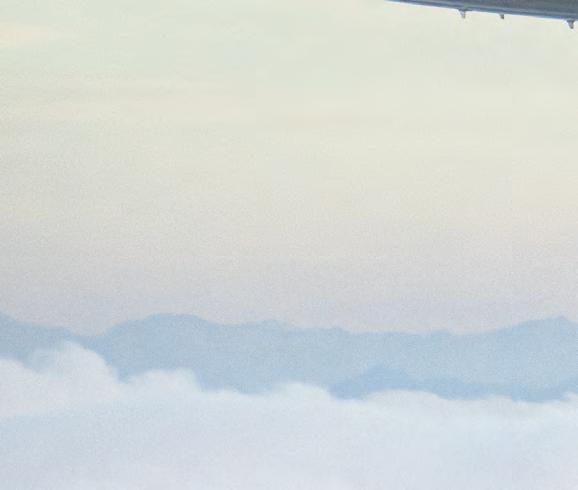









Most of these high-wing, unpressurized models have been approved for amphibious foat installation. Adding foats increases drag, reduces speed, and will swell the price upwards of approximately $500,000. They are also top performers on wheeled landing gear and can easily handle rough, unimproved airstrips.
Base Price: $2.963M
Seats: Up to 9 passengers
Maximum Cruising Speed: 183 knots
Maximum Range: 1,132 nautcal miles
The Kodiak 100 is a foat-ready, single-engine turboprop designed to get in and out of tight spots under harsh conditions. The unpressurized aircraft features a 45-foot-long high wing mated to a rugged aluminum fuselage with a large 54-by-57inch rear cargo door, heavy-duty and high-riding fxed land-
Daher Kodiak 900
Base Price: $3.614M
Seats: Up to 10 passengers
Maximum Cruising Speed: 210 knots
Maximum Range: 1,129 nautcal miles
While not certifed for foat operations, the Kodiak 900 is a larger, faster version of the 100. Compared with the original, the 900 cruises 36 knots faster (210 knots) and has a fuselage stretch of 3.9 feet, enabling greater payloads. Heavily loaded, the 900 climbs to 12,000 feet in just 11 minutes. Cabin volume increases from 248 to 309 cubic feet. The extra cabin space allows for the installation of an eight-place, double-club executive confguration. The seats can

ing gear, a time-tested Pratt & Whitney PT6A-34 engine, and Garmin’s G1000 series glass-panel avionics. At 174 knots, the airplane will get you about 1,000 nautical miles of range.

be quickly and easily changed to provide more cargo space. While the 900, like the 100, is unpressurized, it includes air conditioning and a two-zone heating and cooling environmental control system.
Base Price: $2.4M
Seats: Up to 9 passengers (typical, can hold up to 13 in commuter confguraton)
Maximum Cruising Speed: 186 knots
Maximum Range: 1,070 nautcal miles
In production since 1984, the model 208 is the short-body version of the Caravan. The rugged aircraft has been extensively updated over the years and now features Garmin glass panel avionics and several diferent cabin layout schemes. Adding amphibious foats drops maximum cruise speed to 159 knots
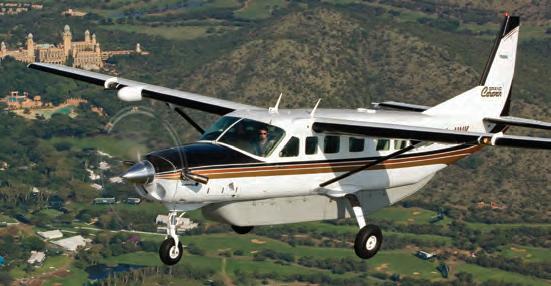
and range to 875 nautical miles. The takeof water run is 2,341 feet (1,160 feet on wheeled gear).
Textron Aviaton Cessna 208B Grand Caravan EX
Base Price: $2.685M
Seats: Up to 9 passengers (13 in commuter confguraton)
Maximum Cruising Speed: 185 knots
Maximum Range: 912 nautcal miles
Deliveries of this updated Grand Caravan began in 2013. It features a more powerful 867 horsepower Pratt & Whitney Canada engine that delivers a 40% increase in the rate of climb and somewhat better specifc fuel consumption. The EX is adept at getting in and out of tight spots: on wheeled gear it requires a takeof run of just 2,160 feet and can land in less than 1,900

feet. The unpressurized cabin measures 16 feet, nine inches long; 64 inches wide, and 54 inches tall. The EX features Garmin G1000 NXi glass panel avionics.
These pressurized, low-wing singles have near light jet performance. While they can’t all equal the short feld performance of their high-winged cousins, these aircraft can still get you into plenty of places that jets cannot go.
Base Price: $4.45M
Seats: Up to 5 passengers
Maximum Cruising Speed: 333 knots
Maximum Range: 1,560 nautcal miles
The carbon-fber E1000 is powered by Pratt & Whitney Canada’s PT6-67A engine, which propels the airplane to its maximum cruise altitude of 34,000 feet in just 15 minutes. The aircraft features the three-screen Garmin G1000 NXi glass-panel avionics system and Genesys digital autopilot. The sculpted cockpit and the cabin both feature the latest automotive styling cues and ofer all the modern conveniences, including USB ports.
Base Price: $5.044M
Seats: Up to 5 passengers
Maximum Cruising Speed: 330 knots
Maximum Range: 1,730 nautcal miles
The TBM 960 is the most recent iteration of a line of singleengine turboprops that date back to the late 1980s. Compared to most of its peers, the TBM’s cabin is on the snug side but its high-speed performance and extended range capability remain popular with pilot-owners.
The 960 has the HomeSafe emergency Autoland system,

The 15-foot-long cabin ofers more space than a twin-engine King Air C90, with a full 31.2 inches of legroom between the facing club seats.
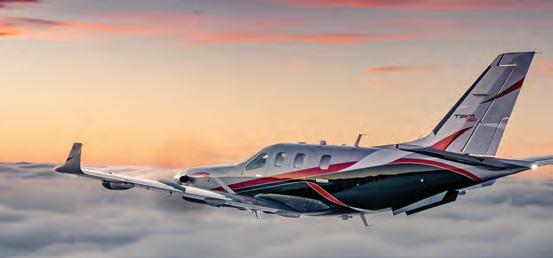
which activates automatically if the pilot goes more than 30 minutes without interacting with aircraft systems. It can also be activated by a passenger in the event of pilot incapacitation.
Base Price: $4.15M
Seats: Up to 5 passengers
Maximum Cruising Speed: 301 knots
Maximum Range: 1,852 nautcal miles
The newest member of the ‘300 Club,’ the Fury is a repowered version of Piper’s previous fagship, the pressurized singleengine M600SLS. The Fury adds 100 horsepower for a total of 700, enabling climbs to 25,000 feet in under 14 minutes and cutting both takeof and landing distances by 700 feet.
Like the TBM 960, the Fury features the Garmin G3000
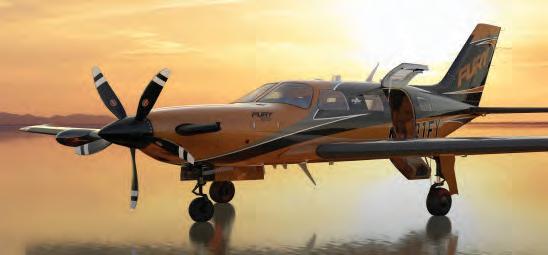
avionics system with the emergency Autoland feature. And like the TBM, its cabin is relatively snug although overall cabin volume is somewhat larger.
These are the top—and most expensive—turboprop singles. They feature range and cabin amenities that rival some light jets and interior dimensions that are equal to, or better, than some twin-engine turboprops.
Pilatus PC-12 NGX
Base Price: $6.2M
Seats: Up to 7 passengers (executve cabin)
Maximum Cruising Speed: 290 knots
Maximum Range: 1,803 nautcal miles (4 passengers, 1 pilot)
The Pilatus PC-12 flls a unique niche in the single-engine turboprop world: a versatile aircraft that can land on short, unpaved felds, swallow outsized payloads through its large aft cargo door, and cruise for six-plus hours comfortably above most adverse weather. With cabin dimensions on par with that of a Beechcraft King Air B200, the PC-12 features a 10% more powerful Pratt & Whitney Canada PT6E-67XP engine, a propeller
Textron Aviaton Beechcraf Denali (in fight test; certfcaton expected in 2025)
Base Price: $7M+
Seats: Up to 7 passengers (executve cabin)
Maximum Cruising Speed: 285 knots
Maximum Range: 1,600 nautcal miles (4 passengers, 1 pilot)
The Denali is aimed squarely at the market for the Pilatus PC-12, which, until now, has not faced a viable competitor.
The Denali’s cabin is the same height as the PC-12’s cabin but 3 inches wider and 2 inches shorter. The aircraft also features a 53-by-59-inch rear cargo door (slightly larger than the one

that can be operated at lower speeds to mitigate external and internal noise, and a variety of avionics improvements designed to mitigate pilot workload and increase safety.

on the PC-12). The Denali’s cockpit is equipped with Garmin G3000 avionics and Autoland. Power comes from the all-new, GE Catalyst engine with single-lever power control. BJT
Survey results from Aviaton Internatonal News reveal which airport facilites ofer the most impressive services and amenites.
By Curt Epstein

The private aviation industry could not function without the existence of fxed base operators (FBOs). These gateway experiences are a crucial component of the system, providing ground handling, parking, hangar space, towing, and, in most cases, fuel for aircraft.
For passengers, FBOs typically ofer amenities including comfortable lobbies and waiting areas, refreshment bars, business centers, conference rooms, and customer-service representatives or concierges to arrange hotels, ground transportation, or even dinner reservations. For pilots and crew, there are lounges, snooze rooms, fight-planning areas, and even courtesy cars.
To determine which FBOs provide the best overall experiences for passenger and crew alike, BJT sister publication Aviation International News has conducted its annual quality survey since 1981. AIN polls a select subset of its industry readership, including pilots, fight schedulers, and dispatchers—those who can evaluate FBOs most knowledgeably. These subscribers have year-round access to a website that allows them to rate FBOs at any time, with their most current rating of a location replacing any previous one.
AIN culled through thousands of responses from the past fve years to compile cumulative average scores in its latest annual lists of the best FBOs in the Americas and the rest of the world.
The magazine asked survey respondents to rate facilities they’d used during the past year on a scale of 1 to 5 in the following categories:
Line service—competence and professionalism of the workers who meet the airplane on the ramp and service it.
Passenger amenities—quality of lobbies, lounges, conference rooms, and refreshments, as well as availability of ground transportation.
Pilot amenities—availability and quality of pilot lounges, fightplanning facilities, snooze rooms, crew showers, entertainment and recreation oferings, and complementary crew cars. Facilities—cleanliness, comfort, upkeep, and convenience of the location.
Customer service—professionalism of customer-service representatives, their familiarity with the local area, and their assistance with reservations and catering.
The survey responses demonstrate that to be a top-scoring FBO, it is not enough to excel in only one area. Facilities must demonstrate excellence across the board. For example, while two locations each earned the highest scores in two of the fve categories this year, one ranked among the top 20 percent of FBOs in the Americas, while the other placed below that threshold.
In the 2024 AIN survey, Texas and Florida dominated the top 5% of FBOs, with those states each felding fve locations or one-third of the top tier each. No other state had as many as two, with the remaining fve slots flled by facilities in Michigan, Tennessee, Colorado, Alabama, and Idaho.

For the fourth consecutive year, Pentastar Aviation, a full service-provider at Detroit-area Oakland County International Airport (KPTK), has received the highest score (4.81) in AIN’s annual FBO survey. The company—born from the former Chrysler fight department—has evolved over the past six decades to become an independent, full-service FBO, ofering a gamut of maintenance, completions, and refurbishment services. Pentastar also ofers a robust aircraft charter and management division in addition to traditional aircraft handling, fueling, and sheltering.
For the second straight year, it is the only facility to be ranked among the top 10 locations in all fve categories: line service (4.83), passenger amenities (4.76), pilot amenities (4.77), facilities (4.79), and CSRs (4.89).
The Avfuel-branded complex is home to 30 turbine-powered aircraft ranging from a BBJ-8 to an Eclipse very light jet. It includes 155,000 square feet of hangar space and 10 acres of reinforced ramp space. The main 5,000-square-foot terminal ofers passenger lounges, multimedia-equipped conference rooms, company ofces, and the Five-Star Cafe. The latter houses the company’s in-house professional catering department, which has become so popular that in addition to serving customers at neighboring FBOs, it also services operators at other airports in the region.
The complex also includes the Stargate, a separate large-aircraft charter terminal with its own baggage carousel and what is believed to be the only privately operated jetway in the country.
In second place this year, with an aggregate score of 4.78, was American Aero at Fort Worth Meacham International Airport (which was recently sold to Modern Aviation) followed by Sheltair at Tampa International which earned a score of 4.76.
AIN’s annual FBO survey divides the world into two groups: the Americas and the Rest of World (RoW). This year, UK facilities dominated the top of the charts in the latter group with designated business aviation gateway Farnborough Airport (EGLF)—with its overall score of 4.67—once again earning the highest accolades in the survey, as it has virtually since the day it opened two decades ago. While the RoW FBO scores tend to lag those of the Americas, London-area Farnborough’s score would have placed it frmly amongst the top 10% of all service providers this year. The complex earned top 10 scores in the passenger (4.76) and pilot amenities (4.73) categories this year, and the second highest score overall for facilities (4.86).
Its three-story 52,000-square-foot terminal features VIP customer lounges that can accommodate up to 60 people for highcapacity fights, conference rooms, crew lounge and snooze rooms, work area, passenger and crew shower facilities, and laundry service. It even has a fully-equipped gym attached to one of its hangars.
Drive-through customs and immigration clearance and rampside vehicle access is available, along with an on-airport hotel. Farnborough is in the second year of a £55 million ($69.5 million) investment program that will increase the airport’s existing 240,000-square-foot hangar space by 70%.
Second place saw a tie between two FBOs at London Stansted Airport (EGSS): Harrods Aviation’s The Brompton (formerly the Fayair complex, which Harrods acquired last year) and Universal Aviation; both received a score of 4.61. Following them, with a tally of 4.54, is Harrods’ original location at EGSS—now known as The Knightbridge to distinguish it from its newer sibling—giving the London airport the unusual honor of having three FBOs in the top tier of the Rest of World segment this year. BJT

BUSINESS JET TRAVELER’S 14th ANNUAL
Here are the results of our 2024 Readers’ Choice survey, which attracted over 1,000 respondents. As promised, we have made a contribution for every completed survey to Corporate Angel Network, which arranges fights on business aircraft to treatment centers for cancer patients.
FLYING PRIVATELY
How long have you been fying privately?*
I haven’t fown privately but am considering it
*Respondents who indicated that they had no plans to fy privately are excluded from these stats and were not asked any of the questons that follow.
About how much do you fy privately in a typical year?
Which of the following have you done in the past two years or plan to do within the next two years? (select all that apply)
The frst tme you ever few privately was…
Which of the following do you least like about airline travel? (select all that apply)
On your company’s aircraf On a friend’s aircraf
On an aircraf you wholly owned On a charter fight you booked On a colleague’s aircraf
Fly via a corporate-owned aircraf
Fly in my own aircraf
Fly via charter
Fly via a fractonal-aircraf share
Fly via a jet card or membership club
On an aircraf you fractonally owned
Wait tmes in airports
Via a jet card you purchased
Unreliability of fight schedules
Lack of privacy
Lack of airports near my departure points and/or destnatons
Inability to conduct business onboard
Inadequate onboard amenites/comforts
Do you select the FBO when booking fights or leave it up to the provider or fight crew?
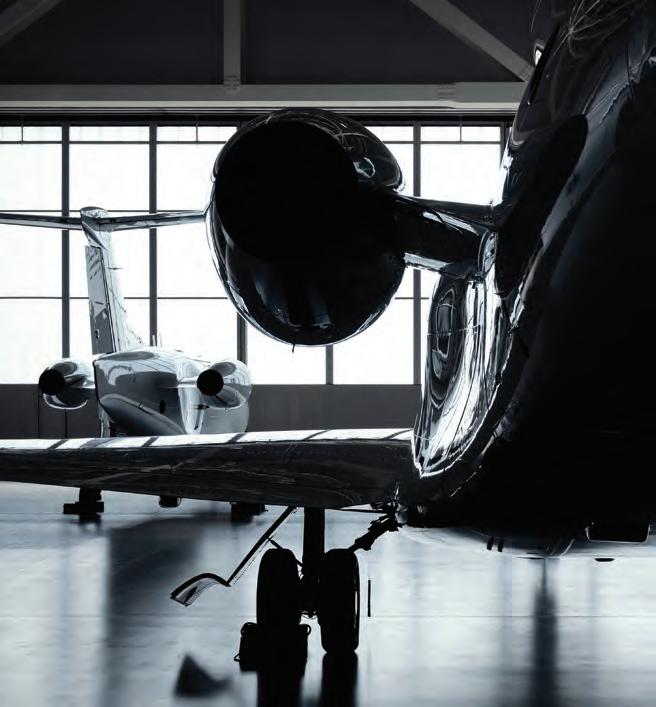
If you fy via charter, do you plan to…
Move up to a fractonal jet share
Return to the airlines at some point
Contnue chartering indefnitely Move up to whole ownership of an aircraf Move up to a jet card
Please give your impression of the following lif providers by ratng them on six criteria: Aircraf model choices, Availability of aircraf on short notce, Customer service, Peak-day policies, Value for price paid, and Overall satsfacton*.
Please indicate your overall impression of each of these aircraf manufacturers*.
Gulfstream
Dassault Falcon
Bombardier
Embraer
Pilatus Sikorsky
Airbus Corporate Jets
Bell
Textron Aviaton
Airbus Helicopters
Boeing Business Jets
Daher
Helicopters
*Results exclude respondents who answered “Don’t know/not sure”, **Determined by assigning points to ratngs:
If you could regularly fy on any of these aircraf, which would you choose in each category?
Pilatus PC-12 | 59 %
Cessna Caravan | 15 %
Daher TBM 960 | 15 %
Piper M700 | 6 % Epic E1000 | 3 %
Daher Kodiak | 1 %
Cessna Citaton Lattude | 34 %
Embraer Praetor500 | 30 %
Gulfstream G150 | 21 %
Cessna Citaton XLS+ | 15 %
Gulfstream G700 | 36 %
Bombardier Global7500 | 26 %
Gulfstream G650/G650ER | 15 %
Dassault Falcon8X | 15 %
Gulfstream G600 | 5 %
ULTRA-LONG-RANGE/HEAVY JETS
Bombardier Challenger 3500 | 38 %
Gulfstream G280 | 25 %
Cessna Citaton Longitude | 21 %
Embraer Praetor600 | 16 %
Gulfstream G500 | 45 %
Bombardier Global5500 | 24 %
Dassault Falcon7X | 21 %
Dassault Falcon6X | 10 %
Boeing BBJ (737 series) | 34 %
BoeingBBJ widebody | 28 %
AirbusACJ320 series | 14 %
AirbusACJ widebody | 13 %
AirbusACJ TwoTwenty | 11 %
Bell 505 | 41 %
AirbusHelicopters H130 | 27 %
LeonardoAW119 | 16 %
MDHelicopters MD500series | 11 %
RobinsonR66 | 5 % Enstrom 480/480B | 2 % LIGHT TWIN-TURBINE HELICOPTERS
Bombardier Global6500 | 4 % LIGHT SINGLE-TURBINE HELICOPTERS
BIZLINERS
Bell Helicopter 427/429 | 52 %
AirbusHelicopters H135 | 30 %
Leonardo AW109 series | 18 %
Note:Percentagesdon’talwaysequal100duetorounding.
Sikorsky S-76 series | 38 %
Bell412 | 23 %
AirbusHelicopters H160 | 16 %
LeonardoAW139 orAW169 | 13 %
AirbusHelicoptersH145 | 10 %
TWIN-TURBINE HELICOPTERS
AirbusHelicopters H175 | 29 % Sikorsky S-92 | 55 %
LeonardoAW189 | 15 %
TWIN-TURBINE HELICOPTERS
Shopping for an airplane or helicopter? Start by reading the key facts about the airframers whose products you’re considering.
Founded: 1970 | HQ: Toulouse, France | ACJ President: Chadi Saade | Employees: 131,000 | Info: acj.airbus.com

Airbus is a multinational aerospace conglomerate that launched its frst passenger jet, the A300, in 1972. The model was the world’s frst widebody, twin-engine passenger jet and marked the initial ofering from what would become Europe’s largest aerospace and defense company.
Airbus forayed into the corporate jet market in 1997, and today the Airbus Corporate Jets business unit ofers the ACJ TwoTwenty, ACJ319neo, ACJ320neo, ACJ330neo, and ACJ350 XWB.
The company, which maintains roughly 180 global locations, has delivered close to 13,000 aircraft since the launch of the A300.
Founded: 1992 | HQ: Marignane, France | CEO: Bruno Even | Employees: 20,000 | Info: airbus.com

Airbus Helicopters is the rotorcraft wing of Airbus. It was founded as Eurocopter Group and was rebranded as Airbus Helicopters in 2014. The company and its predecessor frms have been pioneers in rotorcraft development for decades. In both civil and military applications, Airbus’s helicopters have been bestsellers with a reputation for ruggedness and durability.
The product line includes entries in the intermediate-single, light-twin, medium, super-medium, and heavy segments. In 2017, Airbus Helicopters launched the Airbus Corporate Helicopters business unit, a luxury corporate helicopter development wing, positioning an ofering in every segment from intermediate single to super-medium.
Founded: 1935 | HQ: Fort Worth | President and CEO: Lisa Atherton | Employees: 7,000 | Info: bellfight.com

Bell, a subsidiary of Textron since 1960, is an aerospace manufacturer that has developed civilian and military aircraft and rotorcraft since 1935.
In 1976, Textron rebranded the Bell Helicopter division as Bell Helicopter Textron. This designation remained until 2018 when the company was renamed Bell.
Currently, it manufactures the 505, 407, 429, 412, and 525 rotorcraft for the civilian market. Maximum passenger counts range from four in the 505 to 16 in the 525, which is expected to receive FAA certifcation this year. The company is also developing unmanned aerial vehicles called Autonomous Pod Transports for cargo delivery.
Founded: 1916 | HQ: Arlington, Virginia | BBJ President: Joe Benson Employees: 141,000 | Info: businessjets.boeing.com

The Boeing Company operates in 65 countries and maintains offerings across the aerospace realm, manufacturing aircraft, rotorcraft, rockets, satellites, and communications equipment for civilian and military clients.
Boeing—which lumber industrialist William Boeing founded in 1916—became one of the world’s largest aerospace companies after its merger with McDonnell Douglas in 1997. Its civil aircraft offerings include the 737, 777, and 787. The 737 has been a bestseller since its first flight in 1967, with more than 10,500 deliveries to date.
The company’s civilian aircraft division also produces the Boeing Business Jet series. Narrowbody models of the BBJ are based on variants of the 737, while widebody models include the 777, and 787 platforms.
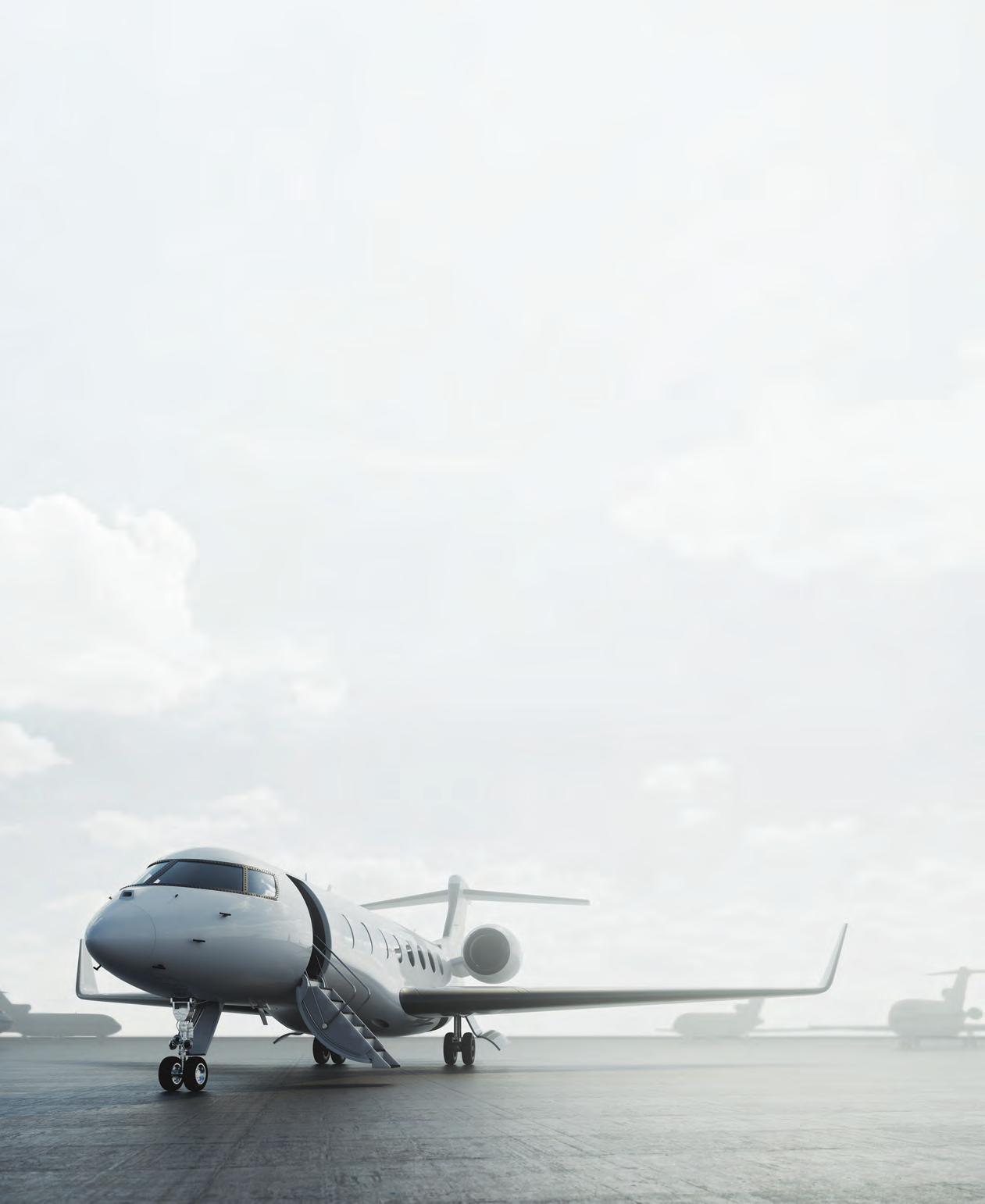
Find out why savvy business aircraft buyers and sellers pick IADA Accredited Dealers and IADA Certified Brokers to ensure transparent, ethical transactions every time.
All IADA Accredited Dealers and Certified Brokers have been thoroughly vetted as the most accomplished advisors in the business. They are at the very top of their profession, and they will work tirelessly to advocate on your behalf.
Keen Wealth Advisors

WHEN KANSAS CITIAN BILL KEEN of Keen Wealth Advisors makes an investment in an airplane for his business, he relies on IADA ACCREDITED DEALER JETAVIVA and its team of specialists to find exactly the aircraft he needs for his missions.
“While acquiring or selling an aircraft could easily be experienced as very transactional, I deeply value my long-term relationship with my friends at jetAVIVA. To date, they have helped me sell two airplanes and buy two, including my most recent acquisition of a late model Pilatus PC 12 NGX that fits my business needs perfectly. The team at jetAVIVA takes the time to listen and understand my needs and brings deep aircraft and market knowledge to the table. From sourcing desirable aircraft with an acceptable maintenance pedigree, to negotiating price and terms, pre-purchase inspections through delivery, their disciplined and professional process has been second to none. I’ll enjoy the NGX but look forward to the next aircraft, when the time comes, with jetAVIVA by my side.”
❚ BILL KEEN Founder and CEO of Keen Wealth Advisors
❚ PRESIDENT & CEO
Privately Held Family Corporate Ofce
“AS A NEWLY REFERRED CLIENT TO IADA ACCREDITED DEALER OGARAJETS, I can confidently say that their service and professionalism exceeded my expectations during the purchase of my aircraft. The experience was seamless, thanks in large part to the ethical standards and business practices that precede their reputation. It was no surprise to me to learn that OGARAJETS was one of the original founding members of NARA, which became IADA.”
❚ FORMER CEO, CHAIRMAN Major U.S.
Transportation Solutions Provider
“OVER THE LAST TWO YEARS, OGARAJETS has assisted my company in buying or selling everything from turboprops and light jets to ultra long range aircraft. With a long family history in aviation, I can honestly say the diference in choosing an IADA ACCREDITED DEALER LIKE OGARAJETS to help us was immediately evident. With a full team dedicated to upholding the highest ethical standards, OGARAJETS ensures every transaction is handled with professionalism.”

❚ KEVIN WARGO
CEO Fly Alliance Orlando, Florida
SCOTT LEEDS, WHOSE RETIREMENT BUSINESS IS THE WALKING L RANCH, uses Omni Aircraft Sales for his aviation needs. The ranch specializes in ‘fast horses & fat cattle’ and relies on a Learjet 60 to fly to thoroughbred horse races, where he has been successful. Omni has helped Scott with a succession of Learjets: an owned Learjet 35, chartered Learjet 45s

FLY ALLIANCE MANAGES AN EXPANSIVE FLEET of Global Express, Gulfstream, Citations and Hawker 800XP business jets for owners, charter and jet cards. CEO Kevin Wargo explains why he chooses OPUS Aero for his business jet transactions. Opus Aero operates from Monaco, Dubai and Montreal.
“We used Aurelie Millet with IADA ACCREDITED DEALER OPUS AERO to buy a Global Express in 2022. Aurelie is knowledgeable within the industry. OPUS is a great advocate for us, and Aurelie assists well in closing smooth transactions. Opus Aero’s knowledge, connections and overall transparency bring ease to our transactions that ultimately lead to great closings and furthered continued success.”
and in 2019 an owned Learjet 60.
“When I look at IADA ACCREDITED DEALER OMNI AIRCRAFT SALES and I look at the history we have had together, and I look to the future as well, I have full anticipation I will continue to use them through the sale of our Learjet 60, purchase of the next aircraft, and on. Omni Aircraft Sales has certifications at
the highest levels. The number one reason I feel strongly about Omni is that they personally, and as a company, are also involved in each aspect of the life cycle of aircraft. From pre-buy, maintenance, management, charter, and then on the sale end, too, they are involved with their own planes. Omni Aircraft Sales are
the absolute experts with the planes that they manage, like mine. I can talk about the Omni guys all day long. They are one of the best outfits I have ever worked with in any business.”
❚ SCOTT LEEDS Retired Software Executive and Investor Tulsa, Oklahoma


The exclusive online marketplace of IADA Accredited Dealers and Certifed Brokers. Unlike unverifed listing sites, we exclusively showcase aircraft authenticated for sale by IADA Accredited Dealers.
Buy or sell your aircraft with confdence at AircraftExchange.com



































Founded: 1942 | HQ: Montreal | President and CEO: Éric Martel | Employees: 15,800 | Info: bombardier.com

A standalone business jet manufacturer since 2021, Bombardier makes and supports Challengers and Globals, spanning the supermidsize to ultra-long-range jet categories.
In 1942 Joseph-Armand Bombardier, a Canadian inventor and entrepreneur, established a company to market his “snow vehicle,” or snowmobile. Four decades later, in 1986, Bombardier expanded into aerospace, acquiring Canadair, which had developed the Challenger 600 series business jet. In 1990, it acquired Learjet. The frst member of its ultra-longrange Global family, the Express, few in 1996, followed by the Challenger 300 in 2001.
In 2018, the fagship Global 7500 entered service. More than 4,700 Bombardier business aircraft are now in operation worldwide.
Founded: 1863 | HQ: Tarbes, France | President and CEO: Didier Kayat | Employees: 9,500 | Info: daher.com

Daher is a diversifed aerospace manufacturing and logistics and supply-chain-services company whose aviation roots date to 1911 with the founding of Morane-Saulnier. It produces the Kodiak and TBM single-engine turboprops and manufactures components for other airframers.
To meet growing demand for its Kodiak and TBM aircraft, Daher plans to open production lines in Stuart, Florida. This will supplement Kodiak manufacturing in Sandpoint, Idaho, and TBM production in Tarbes, France.
In July, Daher delivered the 80th TBM 960, its latest model, and also the 488th of the 900 series to enter service.
More than 325 Kodiaks have been delivered to date. Two versions are available, the Series III, which can be equipped with foats, and the 900, which has a more powerful P&WC PT6 engine.
Founded: 1984 | HQ: Duluth, Minnesota | CEO: Zean Nielsen | Employees: 2,100 | Info: cirrusaircraf.com

Cirrus manufactures the SR line of pistonpowered, single-engine aircraft and the SF50 Vision Jet single-engine jet. The company is owned by the China Aviation Industries General Aircraft (CAIGA) division of state-owned AVIC.
This year, Cirrus delivered its 9,000th aircraft, and the number of Vision Jets in customer hands has exceeded 500.
Recent refnements to the Vision Jet include Garmin’s Auto Radar, which automatically scans the skies and builds a 3D view composite realtime depiction of atmospheric conditions, and Cirrus IQ connectivity. This enables pilots to check on aircraft readiness from anywhere via Cirrus IQ’s LTE cellular telephone connectivity. Items that can be viewed include status of fuel and oxygen levels, aircraft location, fight hours, engine cycles, and other parameters.
Founded: 1969 | HQ: São Paulo | President and CEO: Francisco Gomes Neto Employees: 18,000 | Info: embraer.com

A division of Brazilian aircraft manufacturer Embraer, Embraer Executive Jets (EEJ) produces business aircraft spanning the light-jet to super-midsize categories.
Established in 2005, it introduced the clean-sheet Phenom 100 VLJ and Phenom 300 light jets that same year.
EEJ brought fy-by-wire to midsize jets with the Legacy 450 and 500 in 2008.
In 2020, Embraer announced that it was discontinuing its Legacy 450, 500, and 650, as well as the Lineage 1000.
Current production business aircraft include the 100EX, the 300E, the midsize Praetor 500, and the super-midsize Praetor 600.
Founded: 1929 | HQ: Paris | President and CEO: Éric Trappier | Employees: 12,400 | Info: dassault-aviaton.com

Founded in 1929, this company has a rich history of military and civil aircraft production.
FedEx launched its delivery service in 1972 with a Falcon 20 feet. The Falcon 50 trijet was certifed in 1979. The 900 trijet series entered service in 1986, and the Falcon 2000 midsize twinjet joined the feet in 1995.
The ultra-long-range Falcon 7X trijet, the frst fy-by-wire business jet, entered service in 2007. The longer-range 8X entered service in 2016. In 2018, the airframer debuted the twin-engine Falcon 6X, which entered service in 2023. The company’s new fagship, the large-cabin, long-range Falcon 10X twinjet, will begin deliveries in 2027.
Dassault’s product line includes the Falcon 2000LXS super-mid twinjet, Falcon 900LX largecabin trijet, 8X ultra-long-range trijet, and the 6X.
Founded: 1958 | HQ: Savannah, Georgia | President: Mark Burns | Employees: 13,000 | Info: gulfstream.com
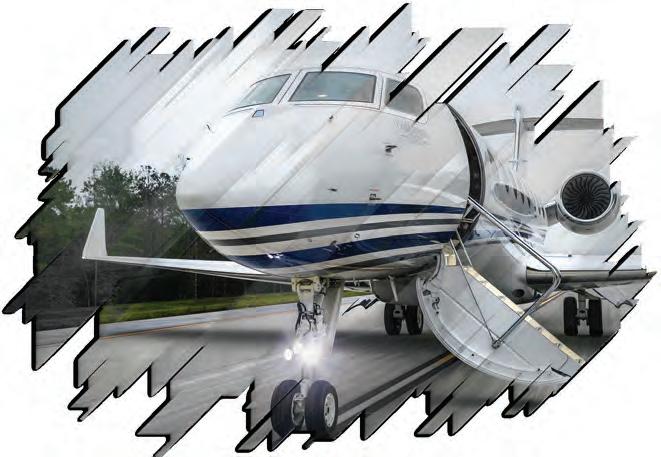
Gulfstream Aerospace focuses on the largecabin market. It was established in 1958 as an outgrowth of Grumman Aircraft Engineering. In 1966, it moved its civilaircraft production to Savannah, Georgia.
In the 1980s, the GIII came to market, as did the Gulfstream IV. The 1990s brought Gulfstream’s frst sales contract with NetJets and the debut of the GV.
In the 2000s, Gulfstream bought Galaxy Aerospace, developing its midsize jets into the G100 and G200. It also introduced the G550, G650, 650ER, G500 and G600.
The product line now includes the supermidsize G280, the G500, G600, and G700, and the 650ER. The next members of the Gulfstream family are the G800 and the G400.
Founded: 2006 | HQ: Greensboro, North Carolina | President and CEO: Hideto Yamasaki Employees: 1,500 | Info: hondajet.com
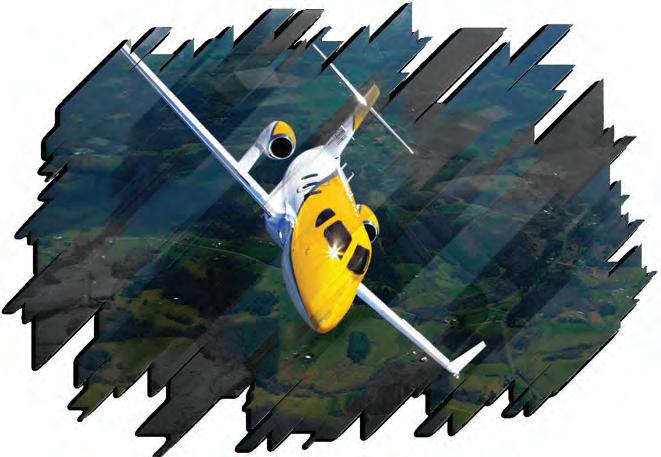
Honda Aircraft manufactures the HA-420 HondaJet. The model was frst delivered in 2015 and the current iteration is the HondaJet Elite S. The twinjet features a patented over-thewing engine mount as well as turbofans that the airframer’s parent, Japan’s Honda Motor Company, developed in partnership with General Electric.
In 2021, Honda unveiled a concept for its next aircraft, the HondaJet 2600, a larger light jet with a transcontinental range of 2,625 nautical miles and a midsize-jet cabin that seats up to 11 passengers.
Now called the Echelon, the design also has the over-the-wing engines. Performance goals include a maximum cruise speed of 450 knots and a maximum altitude of 47,000 feet.
Founded: 1948 | HQ: Rome | CEO: Alessandro Profumo | Employees: 50,400 | Info: leonardo.com

Leonardo manufactures a wide variety of rotorcraft and fxed-wing aircraft for civil and military applications.
Formerly Finmeccanica, Leonardo was founded in 1948. Agusta represented the rotorcraft branch of the business, which began developing and manufacturing helicopters in 1952 under license from Bell.
Agusta frst few the A109 in 1976. A lightweight, twin-engine utility helicopter, the A109 has proven to be the company’s bestseller and is still manufactured today.
Leonardo produces the AW109S, AW119Kx, AW139, AW169, AW189, and AW101 for civilian applications.It operates from more than 150 locations and has a helicopter assembly, support, engineering, and training facility in Philadelphia.
Founded: 1955 | HQ: Mesa, Arizona | CEO: Brad Pedersen | Employees: 250 | Info: mdhelicopters.com

MD Helicopters traces its roots to 1955 when Hughes Tool’s aircraft division began developing light helicopters. After more than six decades and a series of mergers and divestments, it was recapitalized as an independent company in 2005. Since then, it has grown its global feet presence to more than 2,500 aircraft.
After successes with the civil and military rotorcraft, Hughes sold its helicopter division to McDonnell Douglas in 1984. In 1997, McDonnell Douglas and Boeing merged and in 1999, Boeing sold the commercial rotorcraft lines formerly produced by McDonnell Douglas to MD Helicopter Holdings. MD Helicopters emerged from bankruptcy in 2022, and civilian rotorcraft currently in production include the single-engine MD 500E and 530F.
Founded: 1939 | HQ: Stans, Switzerland | CEO: Markus Bucher | Employees: 2,000 | Info: pilatus-aircraf.com
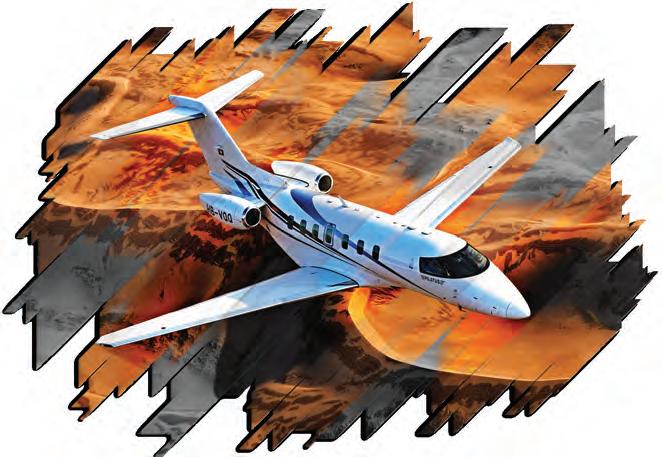
Pilatus Aircraft began manufacturing military training airplanes in the 1940s and launched the legendary PC-6 Porter short-takeof-andlanding aircraft in 1960. The PC-12 singleengine business and utility turboprop entered service in 1994. Pilatus has since delivered 1,900 of the aircraft, whose newest iteration, the PC-12 NGX, features a more powerful Pratt & Whitney PT6E-67XP engine, single-lever power control, and larger cabin windows.
In 2018, the company began deliveries of its twin-engine PC-24 Super Versatile Jet, an aircraft capable of takeof and landing on unimproved, rough airfelds and hauling outsized cargo, thanks to an oversized rear cargo door and fexible cabin layout. The single-pilot PC-24 can fy 2,000 nautical miles and at cruise speeds up to 440 knots.
Founded: 1884 | HQ: Villanova d’Albenga (Savona), Italy
Extraordinary commissioner: Vincenzo Nicastro | Employees: 950 | Info: piaggioaerospace.it

Piaggio began producing aircraft engines and airframes in 1915. It entered into a partnership with Gates Learjet in 1983 to begin the development of the twin-engine pusherpropeller turboprop P.180 Avanti. Learjet withdrew from the project in 1986, and the aircraft received FAA certifcation in 1990. The aircraft is now on its third iteration, which is called the Evo. It has a maximum speed of 402 knots at 41,000 feet. With a three-lifting surface design (canard, wing, and horizontal stabilizer) the Avanti sports a timeless modern appearance while providing superior performance compared with competing aircraft, including many types of light jets. The Avanti’s spacious cabin is also a key selling point.
Founded: 1927 | HQ: Vero Beach, Florida | President and CEO: John Calcagno Employees: 562 | Info: piper.com
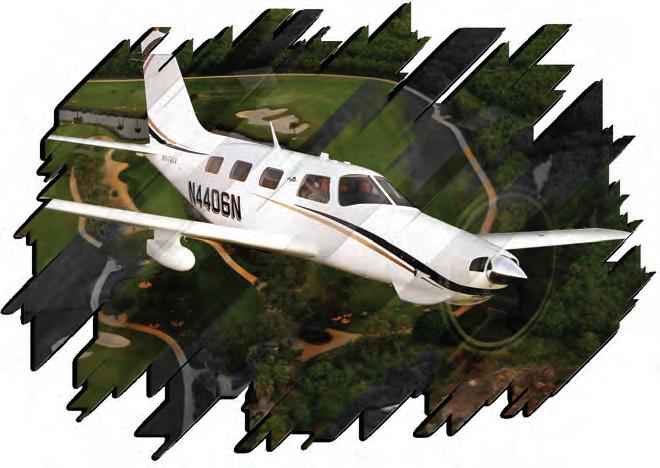
Piper is still perhaps best known for building more than 25,000 of its simple and inexpensive piston single-engine, two-seat Cubs between 1936 and 1947. The iconic yellow fabric, “taildragger” landing gear aircraft distills the essence of pure “stick and rudder” fying in its most basic form. Today, the company builds a full line of piston single and twin-engine aircraft. Those models include piston singles Pilot 100i, Archer, and pressurized M350 and piston twins Seminole and Seneca. Piper also builds two models of turboprop singles based on the M350 fuselage, the M500 and M700. The six-seat M700 cruises at 301 knots and is equipped with the Garmin Autoland system, which can automatically land the aircraft in the event of pilot incapacitation.
Founded: 1925 | HQ: Stratord, Connectcut | President: Paul Lemmo | Employees: 15,000 Info: lockheedmartn.com/en-us/capabilites/sikorsky.html

Lockheed Martin acquired Sikorsky for $9 billion in 2015. Production of its civil models, the S-76D medium twin and the S-92A heavy twin, has languished due to a combination of corporate resourcing priorities, U.S. regulatory changes, and market forces.
Sikorsky made the strategic decision not to bring the S-76D into compliance with new FAA crashworthy fuel tank standards, essentially ending its ability to sell that aircraft in the U.S. market, although it delivered three in 2023.
Meanwhile, long-promised upgrades for the S-92A have been slow in coming because of the recent weakness of the ofshore energy market, which reduced customer demand. Sikorsky delivered three new S-92As in 2023.
Founded: 2014 | HQ: Wichita, Kansas | CEO: Ron Draper | Employees: 9,500 | Info: txtav.com

Textron Aviation was created in 2014 when parent company Textron, Cessna’s owner, acquired the Beechcraft and Hawker brands.
Cessna’s frst business jet, the Citation I (Cessna 500), frst few in 1969. A decade later, Citations were the world’s bestselling business jets.
Cessna sells seven models, ranging from the small-cabin Citation M2 to the super-midsize Citation Longitude. Since they entered service in 1973, more than 7,000 Citations have been produced.
Beechcraft manufactures the G36 Bonanza single-engine piston aircraft, the piston twin-engine G58 Baron, and the twin-engine King Air model 260 and 360 turboprops. Certifcation of its Denali singleengine turboprop is expected in 2025.

As soon as its frst owner departs from the manufacturer’s delivery center, a new airplane technically becomes used (or preowned). For various reasons, however, 10 years after an aircraft’s fnal production date is generally considered the milestone separating ‘newer’ used business aircraft from ‘older’ ones.
In deciding which aircraft to cover, we went well past this 10-year mark to provide information on certifed business airplanes and helicopters manufactured since 2000. This means our list includes some models built before that year, as long as they were still being produced as recently as 2000. As a rule, a long production run is indicative of a successful aircraft.
Visit bjtonline.com/aircraft for an interactive version of these listings.
Cost fgures represent the manufacturers’ list prices for current or mostrecentlyproducedmodels.
The typical passenger seatng on the aircraf is not the maximum certfed seats. These numbers may vary for diferent operatons (corporate, commercial,EMS,etc.).
Cabinvolumeistheinteriorvolume,withheadlinerinplace,without seatsorotherfurnishings.Cabinwidth,height,andlengtharebasedona completedinterior.Widthandheightarethemaximumwithinthatcabin space. In “cabin-class” aircraf, the length is measured from the cockpit

AIRBUS
divider to the af pressure bulkhead (or af cabin bulkhead, if unpressurized). For small-cabin aircraf, the distance is from the cockpit frewall to the af bulkhead.
Forjetsandturboprops,unlessotherwiseindicated,it’sthemaximumIFR rangewithfourpassengerseatsoccupied,usingtheNBAAIFRalternate fuel reserve calculaton for a 200-nautcal-mile alternate. For helicopters, it’stheVFRrangewithallpassengerseatsoccupied.
Year of the frst delivery to the year of the last serial number delivery.
N.A.=NotAvailable
ACJ318Elite$77.42005N.A.195,3007.312.170.96,360 ACJ319$82.01998InProduction195,8437.312.178.86,360 ACJ320$85.01989InProduction196,8257.312.191.06,360
ACJ321$115.01997InProduction198,5477.312.1113.8N.A. ACJ330-800$285.02014InProduction25N.A.7.917.3147.810,400 ACJ330-900$366.52014InProduction25N.A.7.917.3165.29,900 ACJ350XWB$380.02019InProduction25N.A.8.018.4167.411,100 ACJTwoTwenty$81.02021InProduction185,2106.910.977.95,650
BEECHCRAFT (TEXTRON AVIATION)
Beechjet400A$6.71990200373054.84.915.61,318 Hawker400XP$7.82004201083054.84.915.51,318 Hawker750$13.32008201185515.86.021.32,081 Hawker800XP$13.21995200585515.86.021.32,539
Hawker800XPi$13.22005200585515.86.021.32,539 Hawker850XP$14.12006200985515.86.021.32,615 Hawker900XP$16.12007201285515.86.021.32,825
Hawker4000$22.92008201287466.06.525.03,177
PremierI$5.72001200562855.45.513.61,072
PremierIA$7.12006201262855.45.513.61,072
BOEING
BBJ$71.419982021195,3967.011.579.26,230
BBJ2$88.820012021196,5257.011.598.55,722
BBJ3$96.520062021197,2907.011.5107.35,722
BBJMax8N.A.2018InProduction25N.A.7.111.598.36,640 BBJMax9N.A.2020InProduction30N.A.7.111.5107.26,515


BOMBARDIER
Challenger300$21.02003201489306.17.223.73,220 Challenger350$26.72014202289306.17.223.73,356 Challenger604$26.819962007101,1466.18.228.44,033 Challenger605$21.020072015101,1466.18.228.44,063 Challenger650$33.32015InProduction101,1466.18.228.44,000 Challenger850$32.020062012151,9646.18.248.42,946 Challenger3500$27.72022InProduction8N.A.6.07.225.23,400 Global5000$50.420052018131,8896.38.242.55,137 Global5500$47.92019InProduction12–171,8896.28.040.85,900(8pax) Global6000$62.320122018132,0026.38.248.46,600(8pax) Global6500$58.02019InProduction12–172,0026.28.040.86,600 Global7500$78.02019InProduction142,6376.2854.47,700 Global8000$81.0InProduction142,6376.2854.48,000 GlobalExpress$45.519992005132,0026.38.248.46,460 GlobalExpressXRS$58.520052012132,0026.38.248.46,390 Learjet31A$6.51991200362814.45.012.91,251 Learjet40$8.02004200763694.95.117.71,631 Learjet40XR$10.82005201263694.95.117.71,601 Learjet45$10.31998200784154.95.119.81,889 Learjet45XR$13.22003201284154.95.119.81,841 Learjet60$12.61993200374475.75.917.72,134 Learjet60XR$14.72007201374475.75.917.72,182 Learjet70$11.32013N.A.63694.95.117.71,920 Learjet75$13.82013202184154.95.119.81,899

CESSNA (TEXTRON AVIATION)
CitationBravo$6.21997200672924.74.815.81,610
CitationCJ1$4.22000200552014.84.811.0887 CitationCJ1+$5.22005201152014.84.811.01,022
CitationCJ2$5.72000200662484.84.813.61,331 CitationCJ2+$6.52005201562484.84.813.61,452 CitationCJ3$7.32004201562864.84.815.71,748 CitationCJ3+$8.32014InProduction62864.84.815.72,040 CitationCJ4$9.22010In202172934.84.817.32,022 CitationCJ4Gen2$10.752021InProduction10(max)2934.84.817.32,165 CitationEncore$8.12000200673144.84.817.31,695 CitationEncore+$9.22007200973144.84.817.31,712 CitationExcel$10.31998200474225.75.518.51,786 CitationLatitude$16.72015InProduction95876.06.421.12,787 CitationLongitude$27.02019InProduction8N.A.6.06.025.03,422 CitationM2$4.72013202262014.84.811.01,550 CitationM2Gen2$6.52022InProduction62014.84.811.01,550 CitationMustang$3.52006201741634.54.69.8800 CitationSovereign$17.82004201395715.75.525.32,920 CitationSovereign+$17.92013202195855.75.525.33,095 CitationVII$11.41992200074225.75.518.41,742 CitationX$23.11996201285385.75.523.93,140 CitationX+$23.42014201885935.75.525.23,460 CitationXLS$11.32004200984225.75.518.51,871 CitationXLSGen2$15.52022InProduction12(max)4225.75.518.52,100 CitationXLS+$13.02008202184225.75.518.51,896
CIRRUS
SF50VisionG2$2.752016202141704.15.111.51,200 SF50VisionG2+$2.982021InProduction41704.15.111.51,275
Falcon6X$54.92023InProduction161,8458.56.540.05,500 Falcon7X$53.820072022121,5066.27.739.15,754 Falcon8X$65.72015InProduction121,6956.27.742.76,450 Falcon50EX$21.41997200795695.96.123.53,366 Falcon900B$26.219862000121,2706.27.733.24,000 Falcon900C$31.619982005121,2706.27.733.24,000 Falcon900DX$38.020052010121,2706.27.733.24,050 Falcon900EXEASy$41.420032010121,2706.27.733.24,630 Falcon900LX$45.02010InProduction121,2706.27.733.24,750 Falcon2000$24.619952007101,0286.27.731.23,213 Falcon2000DX$29.520082010101,0286.27.731.23,378 Falcon2000EXEASy$30.220042009101,0286.27.731.23,878 Falcon2000LX$32.92007201381,0286.27.731.24,079 Falcon2000LXS$37.02013InProduction81,0286.27.731.24,046 Falcon2000S$28.920132021101,0286.27.731.23,539
ECLIPSE AEROSPACE
Eclipse500N.A.2006200831094.24.77.6574
Eclipse550$2.92013InProduction31094.24.77.61,125

EMBRAER
Legacy450$16.62015202077056.06.824.02,844
Legacy500$20.02014202087056.06.827.53,095
Legacy600$26.020022015131,6566.06.949.83,429
Legacy650$31.620102017131,6566.06.949.83,919
Legacy650E$25.920172019131,6566.06.949.83,919
Lineage1000$53.020092013193,9146.68.884.34,554
Lineage1000E$53.020132020193,9146.68.884.34,600
Phenom100$4.12008201352124.95.111.01,045
Phenom100E$4.32013201752124.95.111.01,178
Phenom100EV$4.32016202352124.95.111.01,178
Phenom100EX$5.02024InProduction52124.95.111.01,178 Phenom300$9.02009201773244.95.117.21,974 Phenom300E$9.52017InProduction73244.95.117.21,811 Praetor500$16.92018InProduction770566.9243,340 Praetor600$20.92018InProduction870566.927.64,018
GIV-SP$32.819922002131,6586.27.345.14,136 GV$43.119952002131,8126.27.350.16,500 G100$12.12001200673045.64.817.12,790 G150$15.72006201675215.85.817.73,018 G200$23.31999201188696.37.224.53,394 G280$24.52012InProduction88886.37.232.33,400 G300$25.520032004131,6586.27.345.13,774 G350$36.020052012141,6586.27.345.13,846 G400$41.520032004131,6586.27.345.14,136 G450$43.220052016141,6586.27.345.14,363 G500(OldModel)$50.520032012181,8126.27.350.15,910 G500$49.92018InProduction131,7156.37.941.55,200 G550$61.520032021181,8126.27.350.16,820 G600$59.92019InProduction191,8846.27.545.26,500 G650$64.52012(nowallG650ER)182,4216.48.553.67,000 G650ER$70.52014InProduction182,4216.48.553.67,500 G700$81.02023InProduction192,6036.38.257.07,750 G800$75.5InProduction182,4216.48.553.6
HONDA AIRCRAFT
HA-420HondaJet$4.5201220185N.A.4.85.012.11,223 HA-420HondaJetElite$5.3201820215N.A.4.85.012.11,437 HA-420HondaJetEliteS$5.4202120225N.A.4.85.017.8422 HondaJetEliteII$7.62023InProduction5N.A.4.85.017.81,547
PILATUS
PC-24$13.52017InProduction85015.15.6232,000 SYBERJET
SJ30$7.32006201052104.34.712.51,876

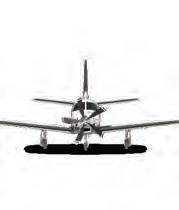
New ($millions)
BEECHCRAFT (TEXTRON AVIATION)
KingAir250$6.32011202063034.84.516.71,051
KingAir260$6.72021InProduction93034.74.516.81,720
KingAir350$6.41990200983444.84.519.21,535
KingAir350ER$7.82008200983444.84.519.21,878
KingAir350i$7.42010202083444.84.519.21,535
KingAir350iER$8.42010202083444.84.519.52,238
KingAir360$8.42020InProduction113444.74.519.51,806
KingAir360ER$8.92020InProduction153444.74.519.52,692
KingAirB200$5.31981200863034.84.516.71,164
KingAirB200GT$5.92008201363034.84.516.71,164
KingAirC90B$2.81992200552184.84.512.4828
KingAirC90GT$3.02006200752184.84.512.4869
KingAirC90GTi$3.42008201052184.84.512.4869
KingAirC90GTx$3.82010202052184.84.512.41,061
CESSNA (TEXTRON AVIATION)
208Caravan$2.01985InProduction92714.55.312.8831
208BGrandCaravan$2.21990201393524.55.316.4786 208BGrandCaravanEX$2.62013InProduction93524.55.316.8738
DAHER
TBM700C2$2.72003200651434.14.010.01,024
TBM850$3.42008201351434.14.010.01,171
TBM900$3.92014201551434.14.010.01,730
TBM910$4.72017InProduction51434.14.010.01,730
DAHER (
TBM930$3.92016201951434.14.010.01,730

TBM940$4.12019202251434.14.010.01,730 TBM960$5.32022InProduction51234.04.013.31,730
Kodiak100SeriesII$2.22008202152484.54.815.51,132
Kodiak100SeriesIII$3.32021InProduction5N.A.4.74.515.91,720 Kodiak900$3.82022InProduction83094.84.518.91,129 EXTRA AIRCRAFT
Extra500$1.7200220155N.A.4.14.613.61,588
PIAGGIO
AvantiEvo$7.42015InProduction63935.86.117.51,410 AvantiP180$6.41990200563935.86.114.91,300 AvantiP180II$7.22014201563935.86.117.51,410
PILATUS
PC-12$3.41995200873564.85.016.91,604 PC-12NG$4.92008201973564.85.016.91,638 PC-12NGX$6.22019InProduction73564.85.016.91,803
PIPER
M500$2.22015InProduction51643.94.212.31,000 M600$2.92016202451653.94.212.31,658 M700Fury$4.12024InProduction51653.94.212.31,852 MeridianPA46TP$2.22001201551063.94.212.31,000

AIRBUS HELICOPTERS
AS332L1SuperPuma$21.719862011124795.15.922.3406 AS332L2SuperPuma$14.81993200794795.15.925.8392 AS350B2$2.4199020144614.35.46.6312
AS350B3(2B)$1.9199720084614.35.46.6300
AS350B3(2B1)$2.1200820114614.35.46.6300 AS355NTwinStar$2.51993200631064.35.46.6320 AS355NPTwinStar$3.9200720144614.35.46.6315
AS365N2Dauphin$6.71990200161864.66.37.2420 AS365N3Dauphin$8.61998201061864.66.57.2354
AS365N3+Dauphin$10.52011InProduction61864.66.57.2341 BK117C1$4.11992200381474.24.96.7221
EC130B4$2.4200020125654.26.17.2280
EC135P1$3.41997200451004.24.75.9254



AW101$28.01994InProduction109706.28.221.3466 AW109Grand$6.42005201051784.25.37.7360
AW109GrandNew$5.52010InProduction51784.25.37.7357
AW109K2$3.81993200351254.34.75.475
AW109Power$4.81997201451254.25.36.9260
AW109Trekker$5.02014InProduction51784.25.37.7357 AW119Ke$3.62007201351214.25.36.9380
AW119Koala$3.02000200651214.25.35.8380
AW119Kx$3.32013InProduction51214.25.36.9380
AW139$11.02004InProduction82824.77.28.9460
AW139Enhanced$11.02016InProduction82824.77.28.9460
AW169$8.02014InProduction62234.36.77.1366
AW189$15.32015InProduction83964.7811.41600
MD HELICOPTERS
MD500E$1.91983InProduction3514.44.53.5174
MD520N$2.61992N.A.3514.44.53.5138
MD530F$2.51984InProduction3514.44.53.5206
MD600N$2.91997N.A.5924.44.56.0235
MD902Explorer$7.21998N.A.41134.14.86.3205
ROBINSON
R66Turbine$1.02010InProduction3504.34.56.7260
SIKORSKY
S-76C+$8.51996200562054.56.38.8335
S-76C++$11.62006201362054.56.38.8335
S-76D$15.02013N.A.62054.56.38.8329
S-92$27.02002InProduction106856.06.419.2439



